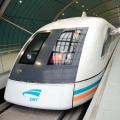The events of the spring of 2014 in Donbass came as a big surprise to many. Moreover, both in Russia - when they learned that there is another Russian region in Ukraine, and in Ukraine - when they learned there that there are powerful separatist tendencies in the Donbass.
Donbass was not lucky, in the sense that until recently, few people were interested in it. Almost no one studied it, did not analyze the processes taking place in the region. Moreover, the processes are public, many even in the region itself are not entirely aware of, poorly monitored by formal sociology and statistics. But in order to understand what is happening in Donbass, you need to do small excursion into the history of this region, try to understand the character and identity of its inhabitants.
The territory of modern Donbass was conquered from the Crimean Khanate The Russian state in the 17-18 centuries. Grigory Grigorievich Kapustin, a Russian self-taught geologist (a native of the present Ivanovo region Russian Federation) under Peter the Great, on the instructions of the Berg-Collegium, carried out two geological expeditions to the territory of modern Donbass, where he discovered, studied and documented the deposits coal... This is where the systemic development of Donbass begins. In the 19th century, when the industrial revolution began in the Russian Empire, it was the Great Russians who became the ethnic basis for the settlement and development of Donbass. This process had absolutely objective reasons. In the mines and factories of a rapidly developing region, they preferred to employ mainly Great Russians from Central Russia, as well as, to a lesser extent, representatives of the Turkic and Finno-Ugric peoples of the Volga region. Since the Little Russians of the Slobozhanshchina and the middle Dnieper region living near the Donbass, they worked seasonally. In late autumn and winter, they still worked relatively stably, and in the spring many of them went home to do agricultural work. Therefore, the region needed people who would work all year round. Therefore, the further you were born from Donbass, the more willingly you were hired. This is what determined the fact that initially almost all large cities and villages of Donbass, as a rule, growing near large industrial facilities, were predominantly Great-Russian in terms of population. Subsequently, another ethnic component gradually poured into these formed cities: Jews, Belarusians, Greeks, Armenians. Those who switched to the language of the urban majority, perceived many elements of Russian culture and self-identification. Becoming a part of what is now commonly called the "Russian World". So the current Russian-speaking Donbass is not the result of some mythical Russification, but a historically conditioned natural process.
Now about the situation with Little Russians and Ukrainians. The current Ukrainian historical and ethnographic science is trying to equate these concepts. Although this is far from the case. Little Russian is, in the Russian Empire, a person who spoke the Little Russian dialect of the Russian language, but often had a general Russian self-identification. At that moment as a Ukrainian, this is a purely ethnic self-identification firmly tied to political and value markers. Therefore, when the Ukrainian side publishes the census data for the Russian Empire in 1897 to substantiate the ethnicity of a particular territory, including the Donbass, they are cheating, to put it mildly. The Little Russian component, of course, also plays a certain role in the formation of the population of Donbass. But here it should be noted that he rather quickly lost some specific Little Russian features, in fact, did not stand out in any way from the main population of the region. And only in some villages of the region did the Little Russians retain their dialect and some minor ethnographic features. The absence of a special influence of the Ukrainian component in Donbass is evidenced by the fact that not before the 1917 revolution, nor during the revolution and civil war, we do not observe any special manifestation of Ukrainian life in the region. Neither political nor educational organizations associated with the Ukrainian movement practically operated on the territory of modern Donbass. Except, perhaps, that the public school in the village of Alekseevka of the wife of the then oligarch Ivan Alchevsky - Khristina Alchevskaya.
The pro-Russian orientation of Donbass was especially vividly manifested in November 1917 during the elections to the Constituent Assembly, when in the provincial districts on the territory of present-day Donbass, all together Ukrainian parties received only about 12% of the vote, while it must be understood that the lion's share votes were cast for the "Ukrainian Socialist Revolutionaries" who spoke in those elections exclusively under social, and not national, slogans. In some cities and mining settlements, especially in the central Donbass, zero people voted for the Ukrainian parties. Or like in Horlivka, where only 25 people voted for all Ukrainian lists. The rest of the population voted for the all-Russian parties. Even more demonstrative was the creation of the Donetsk-Kryvyi Rih Soviet Republic (DKRS) on February 12, 1918, as opposed to the Central Rada that existed in Kiev. At the same time, in contrast to the Central Rada, which proclaimed itself to be the power without prior arrangement, the DKSR was created by elected deputies of local councils and looked much more legitimate than its opponents in Kiev. And only harsh Bolshevik party discipline will subsequently force the representatives of the DKSR to agree to the entry of the territory of their republic into Soviet Ukraine. However, there are several points here. At that time, modern Western Ukraine was not part of Soviet Ukraine, and it seemed quite logical to talk about the fact that the urban proletarian (consider pro-Russian) element would be able to quite effectively balance the nationalistic impulses of rural Central Ukraine. Plus, the capital of Soviet Ukraine was in Kharkov, literally a stone's throw to Donbass. This means that the capital will also be under the influence of the pro-Russian proletariat. However, already in those days, the coexistence of Donbass and Ukraine was becoming problematic. First of all, this was due to an attempt to Ukrainize education and office work. The first wave of intensified Ukrainization (early 20s - late 30s) in Donbass failed. The region did not cease to be Russian-speaking, and education in a foreign language did not bring the expected effect, which a rather rapidly developing country hoped for. It was then, just before the Great Patriotic War itself, that the Solomon decision was worked out. In Donbass, primarily in large settlements, it was decided to leave education basically Russian-speaking with an in-depth study of the Ukrainian language and literature. In principle, this scheme will last until collapse. Soviet Union.
In the postwar years, the final formation of the Donbass mentality and worldview took place. Hard work in mines and factories, a high probability of injury, and often death, led to the fact that people who were weak in spirit and body, people who were not able to interact within a large team, did not stay in Donbass. Therefore, the Donbass character has always been different; directness, sometimes turning into excessive naivety; rigidity capable of turning, if required, into cruelty; patience if it is required for the sake of the cause; collectivism; diligence and punctuality. In principle, Donbass has become one of the few mentally really Soviet regions of the USSR. And this did not depend on the fact that the Donetsk regional party organization was the third in the Soviet Union in terms of the number of members of the CPSU, after the Moscow and Leningrad ones. The question was that a person who lived in Donbass felt like a resident of a big country, and that wherever you went, in any direction, for hundreds and thousands of kilometers, there would be people speaking to you in your native language. That you are one of the pillars of the existing superpower, that you are a worker and belong to a respected part of society. All this was superimposed on the fact that the same miners received very good salaries and had a number of social benefits. At least this feeling, which existed for two post-war generations, is engraved in the people's memory as the "golden age" of the region. At the same time, you need to understand that the Donbass people did not have anything parallel, as in other regions of the USSR. There was no religious structure (even if it was in a semi-underground state), there were no ethnic-clan-tribal relations, there were no patriarchal large families with a large number of relatives, in the urbanized Donbass, even close kinship ties were not particularly supported. And really, no matter how strange it may sound, the state was the only institution on which a simple resident of Donbass always relied. Moreover, this state was a state with a center in Moscow, this state spoke with Donbass in its native Russian language, this state saw the historical process in the same way as the bulk of the population of Donbass. Such a Russian-Soviet symbiosis in the worldview.
But here something happens that will ultimately lead to the Donbass tragedy. Two tendencies have emerged, one is all-Union and the other is republican-Ukrainian. The leadership of the USSR saw the same degree of Soviet patriotism that was present in the Donbass and decided that the mission had been accomplished here. Let's build a "showcase of socialism" elsewhere. As a result, Donbass was left practically without preferences, but with the same or even increased obligations to the country. Therefore, where is it better to build a new comfortable residential neighborhood? In the Donbass or the Baltics? The choice fell on the Baltics. Where to open another theater? In Donbass or Western Ukraine? The choice fell on Western Ukraine. And this is very important in the planning and distribution system. In Donbass, the economic and social situation deteriorated over time. There was a shortage of infrastructure facilities, the transport network did not develop, and the sphere of everyday life deteriorated more and more. Donbass was simply forgotten. In Donetsk, for example, after Khrushchev visited him in 1962, only Mikhail Gorbachev became the next general secretary to appear in the capital of Donbass, in 1989. The result of this "oblivion" of Donbass in the all-Union agenda was the miners' strikes of the late 1980s, caused by socio-economic problems. Which, by the way, began in Russia in Kuzbass, and Donbass simply supported. But the very fact of these strikes greatly stirred up public life in Donbass. Serving as the cause of mistrust between the party and state apparatus and the masses. Serving as a sign that the government has lost the working class as its support. Significantly strengthening the processes of disintegration in party and state structures. Which will ultimately lead to the collapse of the USSR.
On the other hand, its processes took place in the Ukrainian SSR, where after Khrushchev's decrees that the national republics should be headed by representatives of the titular nationalities, an ethnocratic system began to take shape. Where, from 1953 to 1991, a non-Ukrainian was found in seven top government positions only once. And the integration of the recently annexed Western Ukraine into the Ukrainian SSR was bearing fruit. It is clear that the leadership elected on the basis of ethnicity began to support nationally oriented creative intelligentsia and even nationalist dissidents for greater legitimacy. Rebuilding the entire humanitarian sphere for yourself. Where are the pastoral images of patriarchal Ukraine, all these wreaths, ornaments, painted pots were slowly replacing the industrial-working and even revolutionary aesthetics. In addition, at that time, the Ukrainian Soviet quasi-statehood had already finally taken shape. In Kiev, in the mid-50s and early 60s, their own ministries and departments were created, which duplicated the all-Union ones, but nothing depended on them. Since the absolute majority of metallurgical, mining, machine-building enterprises, not to mention the defense industry, that worked in the Donbass were supervised directly from Moscow. By the way, on this, in the Donbass they were not allowed to deploy the Ukrainization of education. Enterprises massively needed skilled workers, engineers whose managers could be taught in Ukrainian was impossible. If only because the professional terminology was poorly developed, and what existed caused bewilderment, and sometimes just ridicule, even among Ukrainian-speaking specialists. Therefore, all technical universities in the region were Russian-speaking. Primary and secondary education was adjusted to this fact.
Proceeding from this, the Kiev leadership did not harbor much love for the Donbass people who were too independent and not like them. Although the republican center tried to exercise its power as best it could. For example, during the population censuses in the same Donbass, at the suggestion of Kiev, local enumerators deliberately overestimated the percentage of the Ukrainian population, trying to somehow mark this region as Ukrainian.
The only people in Donbass who were really focused on Kiev, for whom the Kiev republican "bridge" played a big role, were the party bodies. The party hierarchy was strictly observed in Moscow. This made it possible to maximize the saturation of national cadres both in the party bodies and in the republican security forces. For example, in the republican KGB, by 1991, not a single non-native of Ukraine remained in the highest posts. Now there is a lot of talk about the fact that in 1991 Donbass voted for the independence of Ukraine. Those who say this do not understand that the local Communist Party and all the authorities were campaigning for the referendum on independence in Donbass. Those whom the older and middle generation are used to trusting. Local population it was said that the referendum was needed solely in order to throw off the annoying Mikhail Gorbachev. And then they say, the heads of the Soviet republics will gather and re-create the USSR. Many believed this, although of course not all. Donbass turned out to be almost the only region of Ukraine where propaganda was conducted at the grassroots level against the proclamation of Ukraine's independence. This was done by the organization "Interdisposition of Donbass", which handed out leaflets with an appeal to say "no" to Ukrainian independence. But the propaganda opportunities were clearly not equal. In addition, during the independence referendum, there were no independent observers at the polling stations. As a result, the Kiev republican authorities drew such a “for” figure as they wanted. By the way, in Crimea, according to the same Kiev authorities, the majority of the population (this is still without returning Crimean Tatars) voted for the independence of Ukraine.
However, the people of Donbass soon realized that they had been cheated trite. That no one wants to restore the Soviet Union, it didn’t work to pass off a very amorphous CIS for the USSR. Millions of Russians living on their own land suddenly began to realize that they were without a homeland. And then a gradual struggle began, first for their legal rights, and later for returning to Russia.
Already in mid-1992, the Donetsk Strike Committee, which united virtually all the mines of the Donetsk region, called on the country's leadership to transform Ukraine into a federal state. On June 7, 1993, a massive miners' strike began in Donbass, in which most of the region's coal mining enterprises took part. Enterprises of other industries gradually joined the strike. Under pressure from the strikers, the Verkhovna Rada decided on September 26, 1993 to hold a consultative referendum on confidence in the president and parliament. After negotiations with the President of Ukraine Leonid Kravchuk, the Rada, however, two days before the referendum canceled it and decided to hold early parliamentary elections on March 27, 1994 and early presidential elections on June 26 of the same year. At the local level, in September 1993, the deputies of the Donetsk regional council decided to bring the issue of the autonomy of the Donetsk region to the next session. Kiev began to seriously oppose this, the prosecutor's office and all-Ukrainian trade union organizations were connected with the demand that the protesters and the deputy remove the issue of autonomy. In return, the region was asked to receive an increase in the level of economic independence. As a result of this compromise, in the middle of autumn 1993, the Donetsk Regional Council decided to create a Regional Economic Self-Government (REC). This idea was supported by three more regional councils: Lugansk, Dnepropetrovsk and Zaporozhye. The Donetsk Strike Committee also supported this idea, urging the deputies not to stop halfway and seek even greater independence for Donbass. At the same time, it was stated that if the deputies refuse to do this, such an indecisive local government will be overthrown by a strike. As a result, in December 1993, the Donetsk Regional Council decides to stop transferring funds to Kiev until it pays off all the debts to the region. But a compromise could not be reached here. In response to this, the Donetsk Regional Council in March 1994 made two important decisions.
1) the decision to form its own budget, without any regard for Kiev.
2) during the elections to the Verkhovna Rada on the territory of the Donetsk region, hold a referendum with the following questions:
Do you agree that the Constitution of Ukraine consolidates the federal-land structure of Ukraine?
Do you agree that the Constitution of Ukraine consolidates the functioning of the Russian language as state language Ukraine along with the state Ukrainian language?
Do you agree that on the territory of Donetsk region the language of work, office work and documentation, as well as education and science, should be Russian along with Ukrainian?
Are you in favor of signing the CIS Charter, Ukraine's full participation in the economic union, in the inter-parliamentary assembly of the CIS states?
A similar referendum was held in the Luhansk region. As a result, 79 to 90 percent of the voters answered positively to the questions. But Kiev ignored the results of a legitimate regional referendum. In the presidential elections that followed the referendum, Donbass with a record number of votes (Donetsk Oblast - 79% and Lugansk Oblast - 88%) supports Leonid Kravchuk's opponent, Leonid Kuchma. Who went to the polls under the slogan of maximum rapprochement with Russia. In addition, Kuchma, being a deputy of the Rada in 1991, abstained from voting on independence, wrote "Russian" in the Soviet questionnaires in the column nationality, was married to a native of the Urals, Lyudmila Talalayeva, who did not learn Ukrainian even during her husband's presidency. What could Donbass expect from such a person? Well, only improving relations with Russia, correcting mistakes that Kravchuk managed to make and, naturally, expanding the rights of local self-government.
However, the new president literally in the first weeks of his rule began a cruel course towards centralization. On August 6, 1994, Leonid Kuchma issued a decree by which he subdued all the previously popularly elected chairmen of regional, city and district Councils. Then, through a constitutional agreement that grew into the 1996 Constitution of Ukraine, he pushed through the thesis of the country's complete unitarity (although Crimea was called an autonomous republic, its powers did not go far from the usual region). But Leonid Kuchma, being not a stupid person, understood that Donbass, having experienced such a surge of political activity, would hardly accept the loss of its powers so easily. Therefore, since the end of the 90s, Kuchma has been trying to integrate representatives of Donbass financial and industrial groups (FIGs) into his power vertical. On the one hand, they got the opportunity to privatize numerous industrial enterprises in Donbass, and on the other hand, they had to organize a loyalty regime for Ukraine in the troubled region. That is, to destroy and marginalize as much as possible all pro-Russian and separatist public and political groups.
And there was someone to fight with. Also in last years the existence of the Soviet Union in the Donbass, a number of organizations arose that set themselves the goal: the maximum program "preservation of Ukraine and Russia as part of a single state"; and if it does not work out, and Ukraine proclaims independence, then the program is at least "the entry of Donbass into Russia." In Luhansk it was the People's Movement of Luhansk and the Democratic Donbass Movement. In Donetsk, these were the already mentioned "Interdisciplinary movement of Donbass" and "Movement for the revival of Donbass". Immediately after the proclamation of Ukraine's independence, in April 1992, the "Civil Congress of Ukraine" was created in Donetsk, which later transformed into the "Slavic Party". There were dozens of smaller ones: Cossack, Orthodox, military-historical organizations, communities and clubs. All of them were not too numerous. This was affected by the chronic lack of funding, multiplied by pressure from the Ukrainian special services, to which attacks from Ukrainian nationalists were regularly added. But nevertheless, it was from this environment that the very slogans and ideas were put forward that were taken up by larger political forces. At first, these were the Communist Party of Ukraine (CPU), the Progressive Socialist Party of Ukraine (PSPU) and, until 2004, the Socialist Party of Ukraine (SPU), which regularly passed to the Verkhovna Rada. However, none of these political forces, declaring pro-Russian and regional rhetoric, for all the 90s were unable, and did not really want to do anything for their voters. Considering that in the confrontation with the nationalist part of Ukraine, one can make a political career for a long time. This position also interested the Donbass political elite, which logically decided that if the pro-Russian theme is exploited by the left, then why shouldn't we.
In 1997, on October 26, the founding congress of the Party of Regional Revival of Ukraine (PRVU) was held in Kiev. The leader of which was the then mayor of Donetsk, Vladimir Rybak, and its backbone was made up of people from Donbass, headed by Mykola Azarov. In the program of the new political force, all the same programmatic things were recorded as that of the left parties: the official status of the Russian language and the maximum expansion of the rights of the regions, up to federalization. The most interesting thing is that several more parties will join the PRVU in the coming years. As a result, a political association is formed with the hard-to-remember name Party of Regional Revival "Labor Solidarity of Ukraine". Which will take over the entire HLP program and will have three co-chairs. Two from Donetsk (Vladimir Rybak and Valentin Landyk) and one from Vinnitsa - Petro Poroshenko. Yes, that one. So, the current president of Ukraine in the late nineties not only was, but headed a party that demanded an official status for the Russian language and the federalization of Ukraine. But the piquancy does not end there. Party of regional revival "Labor Solidarity of Ukraine", in 2001, was reformatted into the Party of Regions, which in 2004 will nominate Viktor Yanukovych for the post of President of Ukraine. True, at this moment Poroshenko will already leave this party and defect to the camp of Viktor Yushchenko.
However, the first attempt by Viktor Yanukovych to become the president of Ukraine failed. After the announcement of his victory in the CEC, the “orange Maidan” began in Kiev. On the first Saturday after the start of the Maidan - November 27, 2004, the Verkhovna Rada held an emergency meeting to discuss the political situation in the country. Moreover, the Rada building was surrounded by Yushchenko's supporters. At the same time, the "orange" deputies allowed a number of protesters into the parliament building. This actually meant that the deputies were taken hostage by the opposition. As a result, the Ukrainian deputies, being under great psychological pressure, adopted an illegitimate resolution of several points. The main one was that the parliament recognizes the second round of the presidential elections in Ukraine as not fully reflecting the will of the people and a new re-ballot in the presidential elections is scheduled for December 12.
In response to this, on November 26, 2004, in Donbass, a regular session of the Luhansk Regional Council, by a majority vote, decided to create the Autonomous South-Eastern Ukrainian Republic. The next day, November 27, an extraordinary session of the Kharkiv Regional Council decided to create executive committees of the regional and district councils of the Kharkiv region and empower them with the powers of state authorities. It was decided to coordinate actions with the Supreme Council of Crimea, Donetsk, Dnepropetrovsk, Zaporozhye, Lugansk, Odessa, Kherson, Nikolaev regional councils, Sevastopol city council. On November 28, in the Luhansk region, in Severodonetsk, the All-Ukrainian Congress of People's Deputies and Deputies of Local Councils of all levels took place, which brought together about 4 thousand delegates from 17 regions of Ukraine. Almost all the deputies of the local councils of the Donetsk and Lugansk regions were present. The congress stated that in the event that Viktor Yushchenko comes to power, he reserves the right to take adequate actions aimed at protecting the rights of citizens of his regions. The congress also decided to create an Interregional Council of Local Self-Government Bodies of the South-Eastern Regions. In addition, the Lugansk, Donetsk and Kharkiv regional councils announced the reassignment of the police and other state structures and the termination of transfers of money to the Ukrainian state budget.
In the morning, more than ten thousand gathered on the square in front of the Ice Palace of Severodonetsk local residents chanting "Yanukovych!" and "Federalization!" Already in all, among the deputies, words were heard that it was necessary to proclaim the independence of the South-East of Ukraine (historical Novorossia). Almost everyone agreed that if Yanukovych said “Yes,” then a new one would form on the territory of Ukraine. independent state... However, the pale Viktor Yanukovych, who arrived at the congress, said: “I ask you to stop this. Let us agree with you that only on peaceful conditions, only on the conditions of laws and the Constitution, can our future be built today. Therefore, I urge you not to take any radical measures, I repeat, ”The congress ended in nothing. The confused delegates went home. The very fact of the congress in Severodonetsk caused an extremely negative reaction from Viktor Yushchenko. He demanded to immediately initiate a criminal case against the initiators of the parliamentary congress in Severodonetsk. In addition, Viktor Andreevich turned to the population of Donbass, falsely promising to pursue a policy of integration with Russia and free communication in Russian. But no one really believed him.
After the "third round", as a result of which Viktor Yushchenko became the president of Ukraine. A spontaneous popular movement began in Donbass. In Luhansk and Donetsk, as well as in the regional centers of the two regions, permanently operating kind of "Hyde Parks" appeared, where people gathered, exchanged information, distributed leaflets, homemade brochures, read poems, collected signatures, people signed up for a trip to Kiev, so that somehow resist the "orange" dictatorship. There was an incredible emotional upsurge and unity of people. Tent camps were organized in support of Yanukovych. Permanent tent camps were set up in Donetsk, Lugansk and Mariupol. Meetings were held every day. But these tent camps, in contrast to Kiev, were in a complete information blockade. But the people continued to stand. In just one week of January, 5 thousand applications for membership in the Party of Regions were submitted in Donetsk. But the leadership of the regionals has already rushed with separate negotiations to the new "orange" government. The protesters were left on their own. And here the sentiments were already beginning to be radicalized. The situation escalated to the point that with a request to disperse to Donetsk tent city Viktor Yanukovych personally arrived. After this request, the majority of the participants in the town dispersed in an extremely dejected state. But the main thing was done. In this town, groups of pro-Russian radicals have crystallized. Which will build the paradigm "First the independence of Donbass - then joining Russia", without any connection to major political forces. The most visible of these groups will undoubtedly be the organization "Donetsk Republic", which was officially registered at the end of 2005. Their official standard will be the black and blue - red banner, now the official flag of the Donetsk People's Republic. "Republicans" without hesitation began collecting signatures for the independence of Donbass, as a result of which they started having problems with the Security Service of Ukraine. As a result, the organization moved to a semi-legal position, nevertheless continuing to spread its ideas among the residents of Donbass. At the beginning, the "Donetsk Republic" was headed by Alexander Tsurkan, after whose death the reins of government in the organization will be transferred to his deputy, Andrey Purgin. To the future chairman of the People's Council of the DPR, and one of the informal leaders of the "Russian Spring" in Donbass.
At the end of 2007, an organization called "Donbass Rus" was also registered with a program similar to the doctrine of the "Donetsk Republic" and also with the tricolor red-blue-black official flag of the organization. Only with a little more careful official rhetoric. At the same time, the organization "Young Guard" will be created in Lugansk with similar goals. Branches of the military-patriotic organizations "Cascade" and "Oplot" were opened in Donetsk and Lugansk. The latter, by the way, will be the prime minister of the DPR, Alexander Zakharchenko.
In Donbass, during the Yushchenko presidency, dozens of unregistered groups, one way or another, oriented towards Russia, began to operate actively. Starting from monarchists and Orthodox fundamentalists and ending with Stalinists and Eurasians. Many supporters of the ideas voiced by radical pro-Russian groups worked within systemic political groups such as the CPU, the PSPU and the Party of Regions. Trying to influence the situation in the region from their positions. For example, the future people's governor of the Donetsk region, a man who stood at the origins of the "Russian Spring" in Donbass, Pavel Gubarev, was a deputy of the local council from the progressive - socialists.
Therefore, when in February 2014, after the second Maidan, the power vertical collapsed in Ukraine in the shortest possible time, the pro-Russian groups did not repeat the mistake of 2004-2005. When Yanukovych simply leveled the popular movement. In the spring of 2014, organizations and people turned out to be in Donbass who quickly began to fill the power vacuum. These people already had a historically substantiated idea with which they came out to the people, and the idea was consonant with the aspirations of this people. There were some organizations and leaders in the region capable of motivating and structuring the process, moving from words to deeds. Having made an impetus to the formation of state institutions. In the end, these people had a visual and recognizable symbol - a black-blue-red flag raised above checkpoints and barricades. The flag, for which thousands and thousands of people were ready to fight and die.
When the local Donbass financial and industrial group, which was in prostration after the events in Kiev that followed the Euromaidan, and then began bargaining about its future with the new government, tried to take its previous position in the local power vertical, their place was already taken. And even people who were once close to the Donbass FIG, but who took part in the events of the "Russian Spring", in the end, chose the side of the proclaimed republics of Donbass. The initiative slipped away from the hands of the former masters of the region.
This development of events was logical in its own way, but unexpected for both Kiev and Moscow. Since both capitals simply did not notice the latent processes taking place in the Donbass. When the Russian majority of the region and the representatives of other nationalities who joined them, who considered Donbass a multinational Russian region, exhausted all possible peaceful and legal ways to protect their national and social rights (referendums, elections, work through local authorities, collecting signatures, social activities) and turned out to be morally ready for the transition to the national liberation struggle for the right to be masters in their small homeland and for the right to finally unite with their big homeland.
The situation in Donbass is a classic national liberation war. When one region with a different from the rest of the country: ethnic composition, language of communication, mainly another religious jurisdiction, structure economic activity and mass perception of history, wants to disconnect. This struggle has a rather deep background and traditions. And not to take this into account now, seeing in what is happening now in Donbass just a civil war between some Ukrainians and others, is not entirely correct. This approach will not lead to anything good. Not to mention the fact that after what happened, Donbass and Ukraine are unlikely to be able to coexist within common borders. This opportunity has long been left behind.
Polesie, Galicia, Bukovina, Slobozhanshchina ... What do these names tell us? When did they appear? What kind of land is this and who lives on it? We still use these names, although they have long lost their official status. The modern administrative regions of Ukraine are a rather arbitrary division of the territory, which often does not correspond to the realities: the way of life, customs, traditions of residents of neighboring villages of the same district can differ significantly, but in the way of life of residents of different regions, you can find a lot in common. Of course, urbanization has leveled Ukrainians in the east and west, in the south, north and center. However, let's not forget about our past.
Ukrainian ethnography as a science originated at the end of the 18th century. Since that time, attempts have begun to divide the territory of Ukraine into various historical, ethnographic, cultural, dialectal regions. The consequence of this was a large number of variations of this division. Today, you can find at least a dozen different maps, on which scientists indicate the boundaries of "special" areas. And often the opinions of some scientists do not coincide, or even contradict the opinions of others.
For more than 200 years of the existence of Ukrainian ethnology, there have been disputes over the ethnographic zoning of our country. And not a single scientist wants to compromise his position. The same regions are called differently, and their limits are also differently distinguished. And the principles of building maps are different. And this is the decisive moment. What should be taken as a basis: features of construction, traditional clothing, household items and household tools, peculiarities of housekeeping, linguistic dialects, geography, politics? Each scientist chooses a starting point for himself. As a result, there are completely different ethnographic maps. It also matters at what time the researcher lived and worked.
The ethnographic map is also a very conventional "tool" for studying this issue. After all, the boundaries of the distribution of one or another ethnographic group may in reality differ by several tens of kilometers.
The material presented below is not the ultimate truth. To objectively cover this topic, we will have to write several different articles, the content of which will be mutually exclusive. We tried to concentrate more on folk peculiarities, namely on ethnography, and not on politics (therefore, for example, in the article you will not find Donbass, Tavria, division into the left and right banks of the Dnieper, etc.). We advise you to travel around Ukraine, visit museums, where employees will give comprehensive information about their region, its history and features.
In addition to this, we propose to look at several more maps of the historical and ethnographic zoning of Ukraine and adjacent lands:
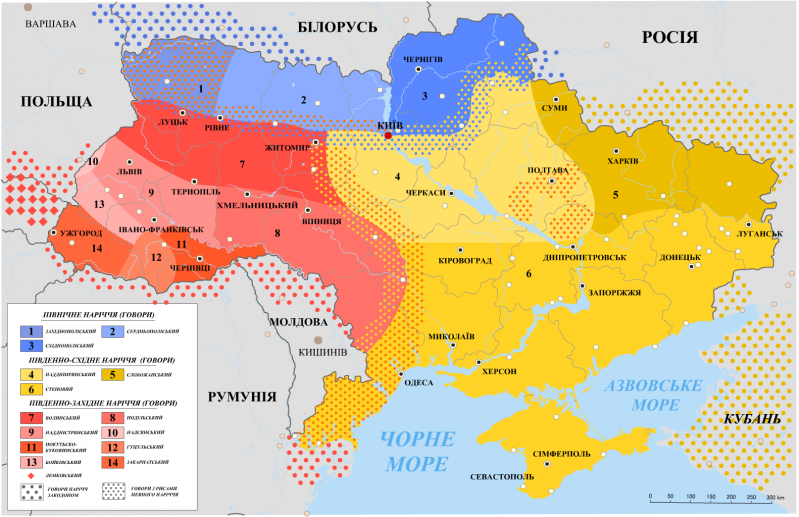 Map of Ukrainian dialects. Photo source: inspired.com.ua.
Map of Ukrainian dialects. Photo source: inspired.com.ua.
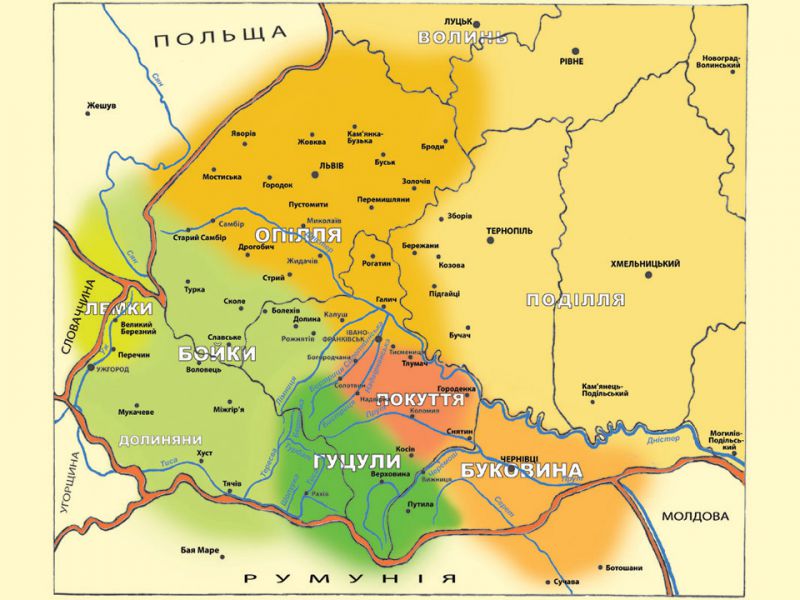
Map of National Museum folk architecture and life of Ukraine (Kiev, p. Pirogov). Photo source: etnoua.info.
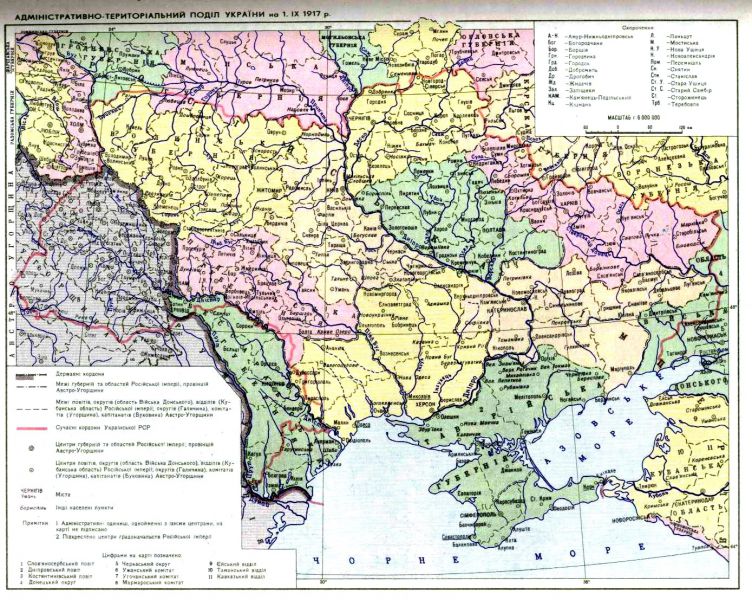 Photo source: etnoua.info.
Photo source: etnoua.info.
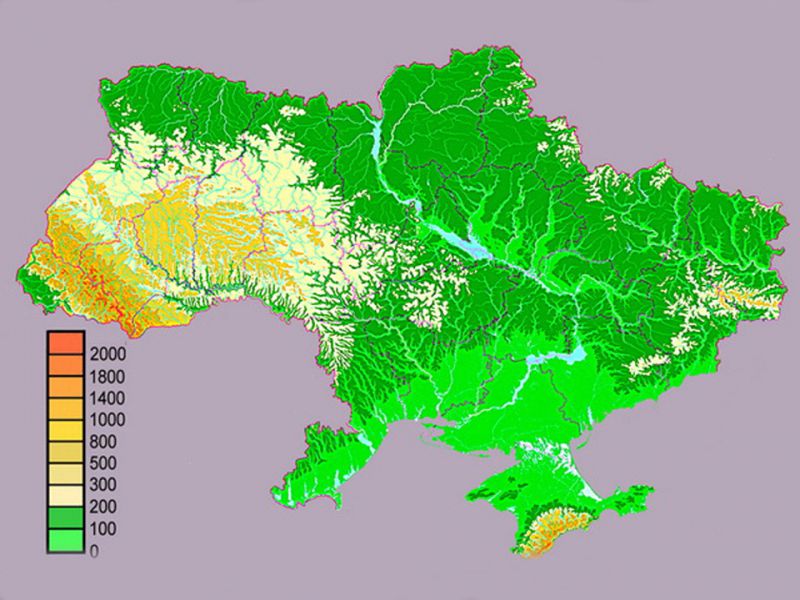 Relief of Ukraine. Photo source: etnoua.info.
Relief of Ukraine. Photo source: etnoua.info.
 Map of 1949. Photo source: nv.ua.
Map of 1949. Photo source: nv.ua.
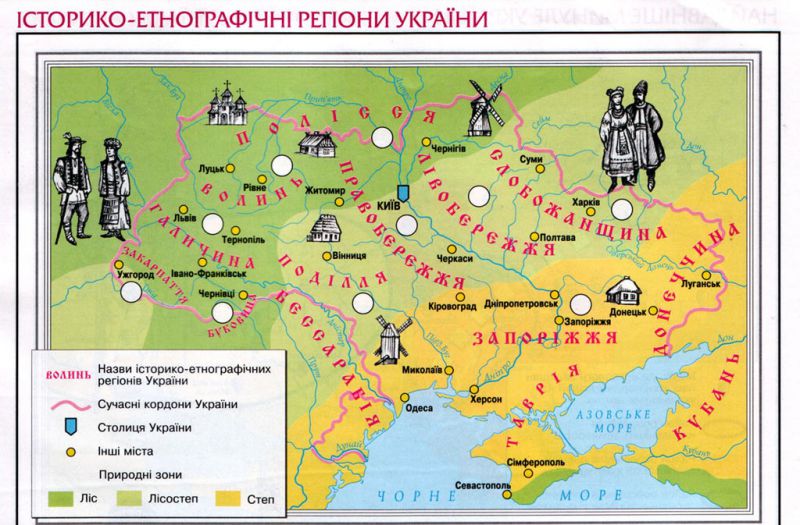 Photo source: nv.ua.
Photo source: nv.ua.
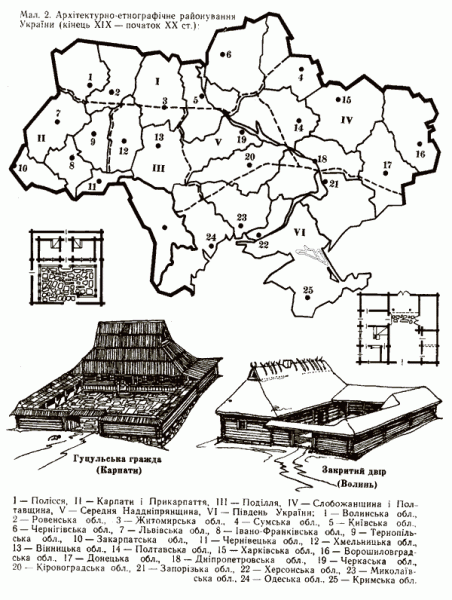
V.P. Samoilovich "Ukrainian national housing (late 19th - early 20th centuries)"; Kiev edition ("Scientific Thought") 1972. Photo source: etnoua.info.
 archive National Center folk culture "Museum of Ivan Gonchar". Photo source: etnoua.info.
archive National Center folk culture "Museum of Ivan Gonchar". Photo source: etnoua.info.
 General geographic atlas of Ukraine; Kiev edition ("Cartography") 2004. Photo source: etnoua.info.
General geographic atlas of Ukraine; Kiev edition ("Cartography") 2004. Photo source: etnoua.info.
 Kiev region: Geographical atlas: My small homeland; Kiev edition ("Map") 2006. Photo source: etnoua.info.
Kiev region: Geographical atlas: My small homeland; Kiev edition ("Map") 2006. Photo source: etnoua.info.
 Photo source: sites.google.com.
Photo source: sites.google.com.

T. Kosmina, A. Kosmina "Ukraine and Ukrainians: Galicia, Bukovina: Historical and Ethnographic Art Album of Ivan Honchar"; Kiev edition ("UTSNK" Museum of Ivan Gonchar ", PF" Oranta ") 2007. Photo source: etnoua.info.
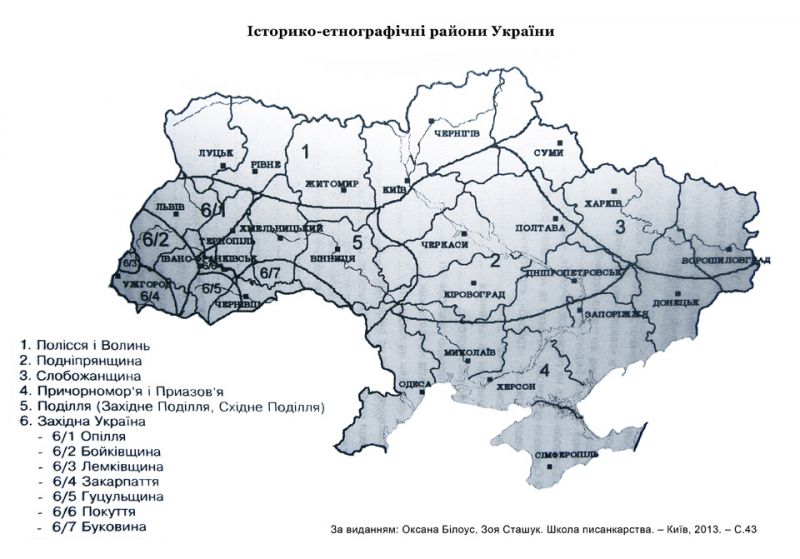 A. Belous, Z. Stashuk "School of Easter Eggs"; Kiev edition of 2013. Photo source: etnoua.info.
A. Belous, Z. Stashuk "School of Easter Eggs"; Kiev edition of 2013. Photo source: etnoua.info.
 History of Ukraine (Introduction to History): a textbook for the fifth grade; Kiev edition ("Genesis") 2013. Photo source: narodna-osvita.com.ua.
History of Ukraine (Introduction to History): a textbook for the fifth grade; Kiev edition ("Genesis") 2013. Photo source: narodna-osvita.com.ua.

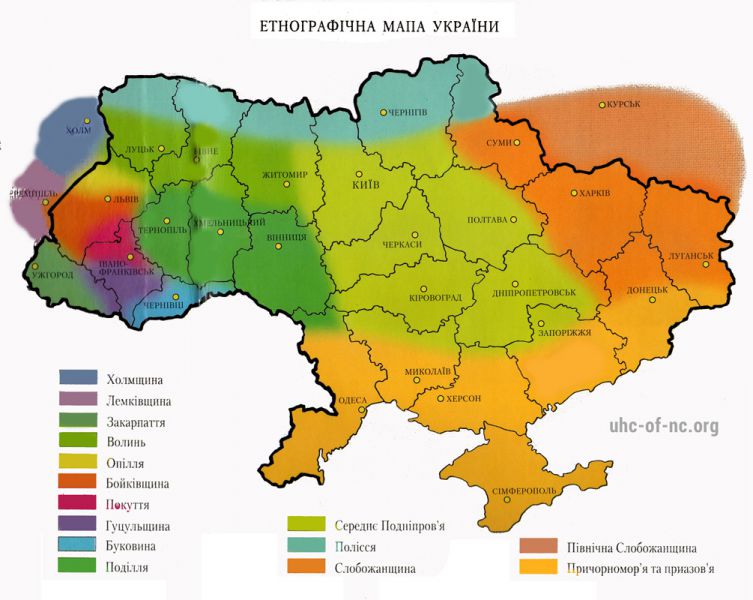 Photo source: uhc-of-nc.org.
Photo source: uhc-of-nc.org.
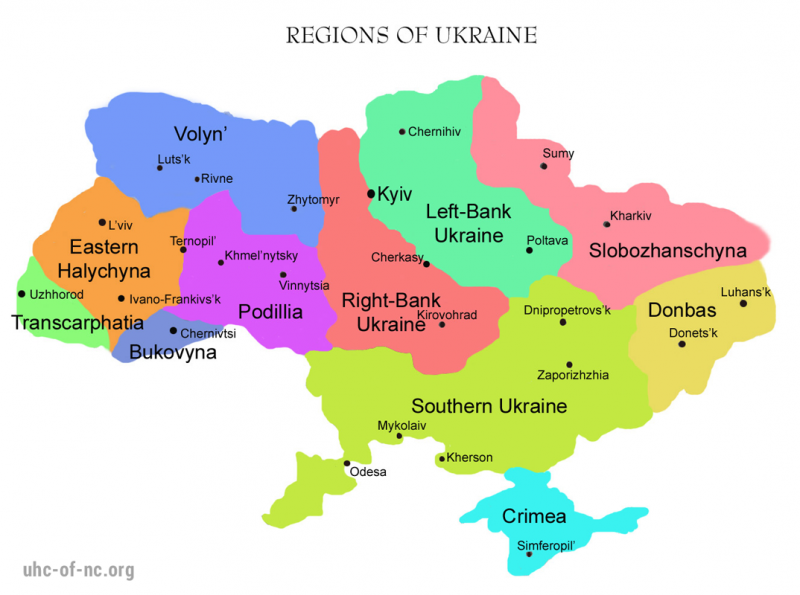 Photo source: uhc-of-nc.org.
Photo source: uhc-of-nc.org.
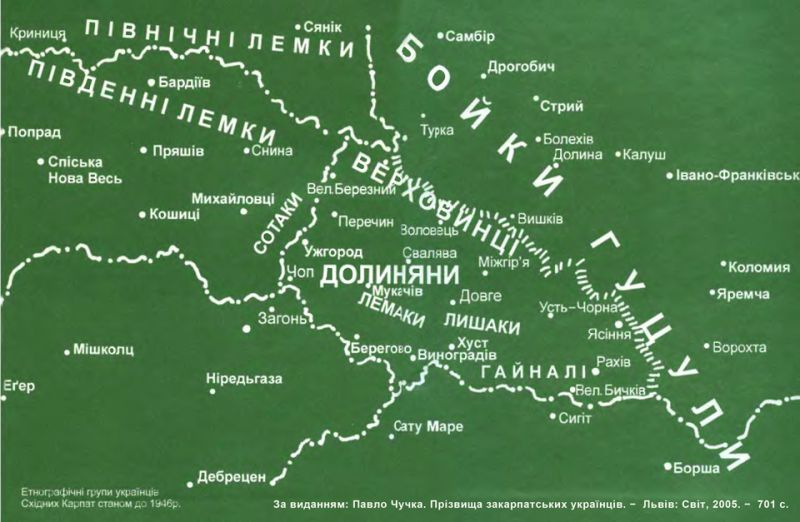 P. Chuchka “Surnames of Transcarpathian Ukrainians. Historical and etymological dictionary "; Lviv edition ("Mir") 2005. Photo source: etnoua.info.
P. Chuchka “Surnames of Transcarpathian Ukrainians. Historical and etymological dictionary "; Lviv edition ("Mir") 2005. Photo source: etnoua.info.

Ukraine and Ukrainians: Galicia, Bukovina: Historical and Ethnographic Art Album of Ivan Honchar; Kiev edition ("UTSNK" Museum of Ivan Gonchar ", PF" Oranta ") 2007. Photo source: etnoua.info.
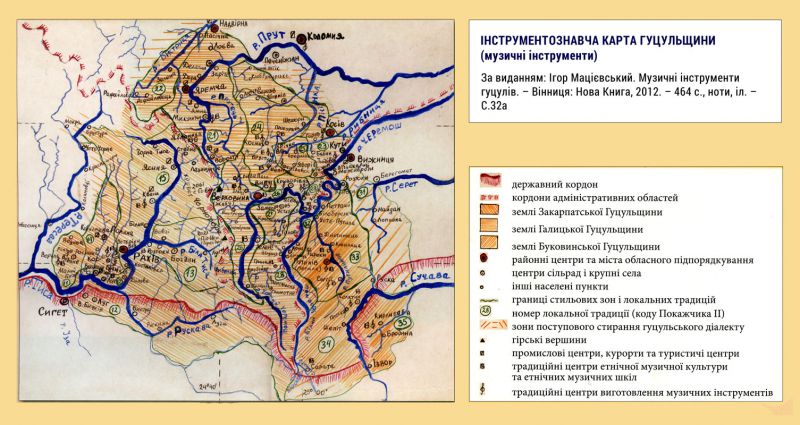 I. Matsievsky "Musical Instruments of the Hutsuls"; Vinnitsa edition ("New Book") 2012. Photo source: etnoua.info.
I. Matsievsky "Musical Instruments of the Hutsuls"; Vinnitsa edition ("New Book") 2012. Photo source: etnoua.info.
Polesie
Let's start from the north. This region includes such modern areas:
- Volynskaya;
- Rivne;
- Kievskaya (northern areas);
- Zhytomyr (northern regions);
- Chernihiv (northern regions);
- Sumy (northern regions).
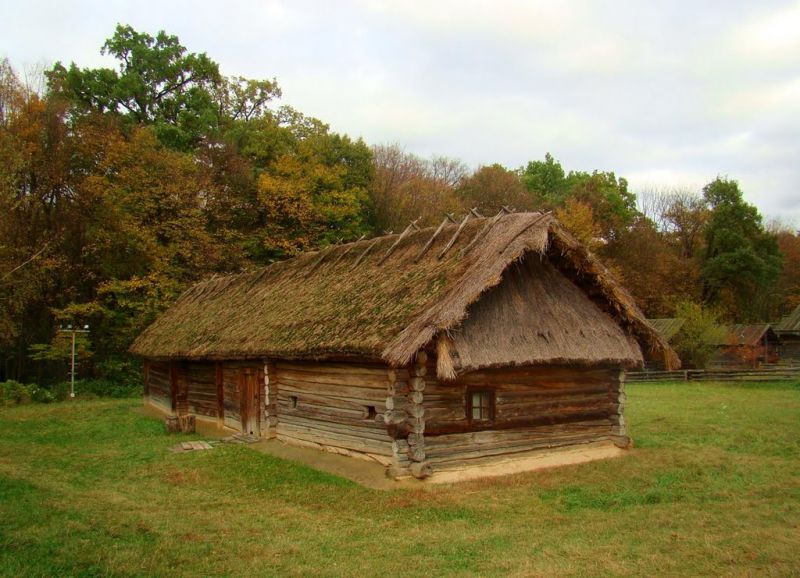 Photo source: ssl.panoramio.com.
Photo source: ssl.panoramio.com.
The name of the Polissya area is easy to deduce from the words "on" and "Forest"... And this is absolutely natural, because the north is forests. So our ancestors settled "Through the woods"... The first written record of this name is found in the Galicia-Volyn Chronicle under 1275. From time immemorial, the people who inhabit this region have been called Polishchuk.

Volyn
Part of the Polesie region, its center in Ukraine is Volyn. This name was first mentioned in the 11th century, or rather half of the year 1077, in the Novgorod Chronicle.
 Photo source: ukrssr.com.ua.
Photo source: ukrssr.com.ua.
Historians and philologists still argue about the origin of the name Volyn.
According to some, the name of this region comes from the name ancient city Volyn, or Velyn. Today it no longer exists, but traces of an ancient settlement found by archaeologists indicate that it was located at the confluence of the Guchva and Western Bug rivers (this is 20 km from the modern Vladimir-Volynsky).
Other scientists associate the name of the territory with the island of Wolin in Pomerania (lands near Baltic Sea, now - regions of Germany and Poland). The Slavs lived on the lands of modern Germany, but at the end of the first millennium they were forced to give up their territories to the Germanic tribes. They conceded the locality, but the name did not. So the Volhynians migrated to the east (to the northwestern territories of modern Ukraine) with their own name.
The origin of the name "Volyn" is also derived from the tributary of the Goryn - Viliya.
However, all these versions do not reveal the main thing - the meaning of the word "Volyn". There are several options here:
- from the Slavic "vol" (ox), that is, "Volova country";
- from the Lithuanian "uola", which means "rock";
- on behalf of such himself Velina, who "commanded", "commanded";
- from the word "olin", which used to be called deer, that is, Volyn is the land of deer;
- if we again remember the Germans, then the word "Volhynia" can be translated as "Celtic", "a representative of the Romance peoples", that is, "alien", "foreigner" (for the ancient Germans, of course);
- The most common version, which is followed by most historians and linguists, is that the name "Volyn" is related to the Proto-Slavic root "ox" (or "vel", "vl"), which means "wet", "wet", " wetland ".
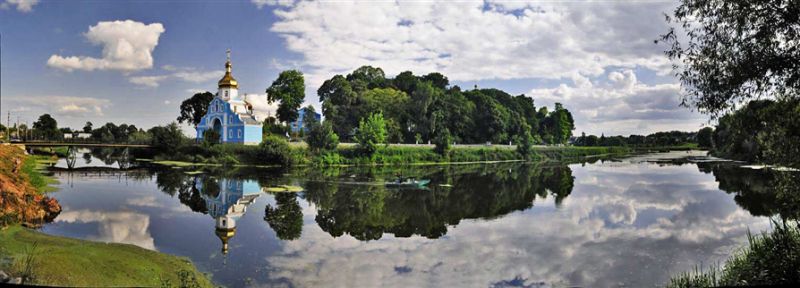 Photo source: foalex.artphoto.pro.
Photo source: foalex.artphoto.pro.
Learn about the life and traditions of the inhabitants of this region in the museums:
- (Otrokhi village, Chernihiv region).
- (Selezovka village, Zhytomyr region).
- (urban-type settlement Manevichi, Volyn region).
- (Novgorod-Seversky, Chernigov region).
- (Krolevets town, Sumy region).
- (Rokini village, Volyn region).
- (Zanki village, Chernihiv region).
- (Chernigov).
Carpathians
The vast region in western Ukraine is divided into the Carpathian, Transcarpathian and the Carpathians proper. The etymology of the first two names is easy to deduce: at-- what is in the Carpathians, that is, in front of them, per- - what's around the corner. Of course, we must make an allowance for the fact that this is the view of the Ukrainians, but, for example, for Slovaks who live on the other side of the Carpathians, everything looks exactly the opposite.
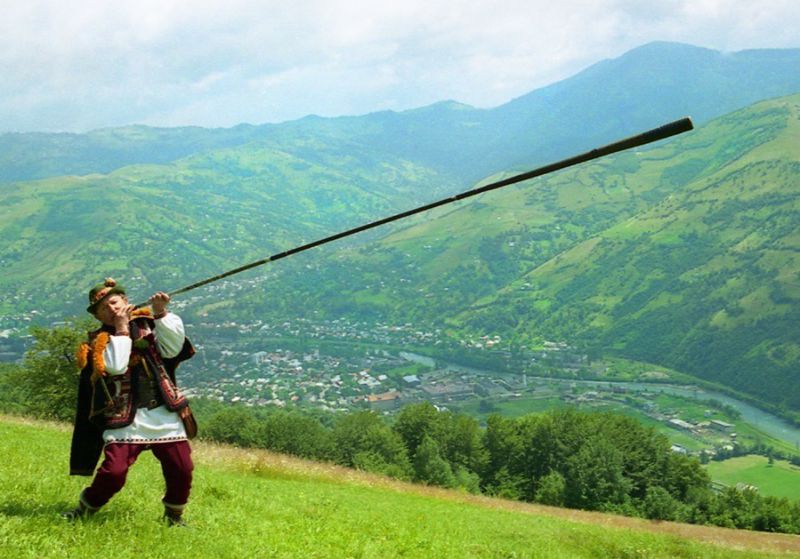 Photo source: khustnews.in.ua.
Photo source: khustnews.in.ua.
Regarding the origin of the name of the Carpathians, it is derived from different words of several languages: from Armenian "carp" - stone, "pat" - wall; from the Polish "carp" - large irregularities, trunks, roots; from the Celtic "karn" - a stone, a pile of stones.
The Carpathian region includes such modern areas:
- Transcarpathian;
- Lviv;
- Ivano-Frankivsk;
- Chernivtsi (west);
- Ternopil (west).
Traveling the Carpathians, you go on a visit to three ethnographic groups: Boykos, Lemkos and Hutsuls.
Boyki inhabit the territories of several regions and districts of Ivano-Frankivsk (Rozhniatovskiy and Dolinskiy districts); Lviv regions (Stryisky, Samborsky and Starosamborsky, Drohobychsky, Skolevsky, Turkovsky districts); Transcarpathia (Volovetsky, Mizhgirsky, Velyky Bereznyansky districts).
Most likely, they got their name due to the peculiarities of their speech: in the local dialect, the particle "boye" means "yes". However, not all strikers agree with this name of their ethnic group. Perhaps due to the fact that it was once a derisive nickname with which they were teased by their neighbors. The strikers themselves often call themselves the Verkhovyns.
![]()
Lemkos, or Rusyns, are autochthonous inhabitants of the Carpathians, they have lived here from time immemorial, occupying lands on the slopes of the Eastern Beskids and northwest of Uzh (in Ukraine they live in the north of the Transcarpathian region). In written sources, they were first mentioned in the 6th century.
Neighbors began to call this ethnic group Lemkos, and all due to the fact that in the language of the Carpathian Rusyns “to connect words” the particle “lem” was often used, which meant “only, only”.

Hutsuls live on the territory of Nadvornyansky, Verkhovynsky, Yaremchansky and Kosovsky districts of Ivano-Frankivsk region, in the Rakhivsky district of the Transcarpathian region and in the Putilsky district of Chernivtsi. It is these lands that are popularly known under the unofficial name "Hutsulshchyna".
The name of the Hutsuls is associated with the Moldovan word "huts" ("gots"), which translates as "robber". However, the robber is not easy, but noble, because among the representatives of this ethnos there were many rebels, people's avengers.
Linguists derive the name of the Hutsuls from the word "gochul" (or the variant "kochul") - a nomad. Sometimes the origin of the ethnos, and therefore the name, is associated with the Ulitsy tribe.
The versions of the origin of the Hutsuls are also interesting. Whoever is not called their ancestors: the Etruscans (the civilization that inhabited the territory of modern Italy), and the Thracians (the people who lived in the Balkans), and the Caucasians.

However, let us return to the territories in which these ethnic groups live.
With Transcarpathia, everything is simple. Transcarpathia, as it was behind the Carpathians, remained there. Therefore, both the modern name and the allocation of the territory into an administrative unit - the Transcarpathian region - are not far from the truth, at least as regards the borders of modern Ukraine.
Galicia
Occupies the territory of modern Ivano-Frankivsk, Lviv, Ternopil regions. European Gaul (a state that existed 2 thousand years ago in the south of modern France) and Galatia in Asia Minor (now the territory of Turkey) got their names from the Celtic tribes who inhabited the territory of the Old World in the 1st millennium BC and left a mention of themselves here. The Greeks and Romans called the Celts Galatians and Galami. It can be assumed that the origin of Ukrainian Galicia is also connected with the common European history. Once its capital was the city of Galich, whose name some scientists derive from the name of the ancient Celts. Other researchers disagree with this version and make their own assumptions: from the word "jackdaw", from the Polish hala - mountain, from the princely name Galitsa (which is buried somewhere on the territory modern city), from the Alazons, or Galizons (the people who lived along the Dniester and Bug), from the Greek gals - salt (in North-Eastern Russia, the salt-making center was called Galich), from the word "galitsa" - a snake.
![]() Photo source: nichlav.blogspot.ru.
Photo source: nichlav.blogspot.ru.
Pokutiye
A small area of the Carpathian region. This is a part of the Kosiv region of Ivano-Frankivsk region, a flat area between the Prut and Dniester rivers. With the origin of the name Pokute, everything is simple and unambiguous. It is associated with the village of Kuta (translated from Ukrainian - angles). After the seizure of Ukrainian lands, the Poles began to mark the boundaries of their possessions in the east with this particular settlement. They said something like: “Our lands by Kuta". Today it is conventionally the southeastern corner of Galicia.
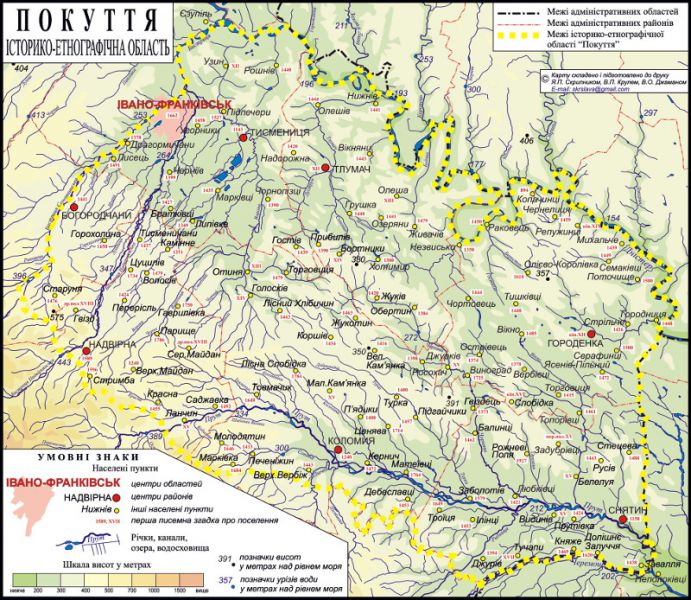 Photo source: hutsul.museum.
Photo source: hutsul.museum.
Bukovina
It is not difficult to deduce the name of the Bukovina region. It is associated with beech forests, which, as you might guess, grow on the territory of the modern Chernivtsi region. It is the areas of this administrative unit of Ukraine that are Northern Bukovina - part of the greater Bukovina, southern lands which belong to the territory of Romania.
 Photo source: mapsof.net.
Photo source: mapsof.net.
Visit the colorful ethnographic museums of the Carpathian region:
- (Lviv).
- (Kolomyia, Ivano-Frankivsk region).
- (Uzhgorod).
- (Plavye village, Lviv region).
- (Chernivtsi).
- (Krylos village, Ivano-Frankivsk region).
- (Kosiv, Ivano-Frankivsk region).
- (Sambir, Lviv region).
- (urban-type settlement Kuty, Ivano-Frankivsk region).
- (the village of Kolochava, Transcarpathian region).
- (Lviv).
- (village Belaya Krinitsa, Chernivtsi region).
- (the village of Sajava, Ivano-Frankivsk region).
- (Valyava village, Chernivtsi region).
- (Tlumach, Ivano-Frankivsk region).
- (Dolina, Ivano-Frankivsk region).
- (Monastyriska, Ternopil region).
- (urban-type settlement Verkhovyna, Ivano-Frankivsk region).
- (urban-type settlement Verkhovyna, Ivano-Frankivsk region).
- (Sarny, Rivne region).
- (Yaremche, Ivano-Frankivsk region).
- (Chernivtsi).
- (the village of Marinin, Rivne region).
- (the village of Kryvorivnya, Ivano-Frankivsk region).
Podillia
Ukrainian chronicles mention these territories under the names "Lower" and "Lower Russia" (13th century). The name Podillia is first encountered in documents from the 14th century. The historical district of Podillia includes such modern Ukrainian lands:
- Zhytomyr region (southwest);
- Rivne region (south);
- Ternopil region;
- Khmelnitsky region;
- Vinnytsia region;
- Odessa region (north).
 Photo source: bigfoto.in.ua.
Photo source: bigfoto.in.ua.
Podolyans live here. Do you remember the famous Ukrainian folk song: "Here there is a podolyanochka bole, here there is a youthful boolean"? So, it is about a charming inhabitant of this particular region.
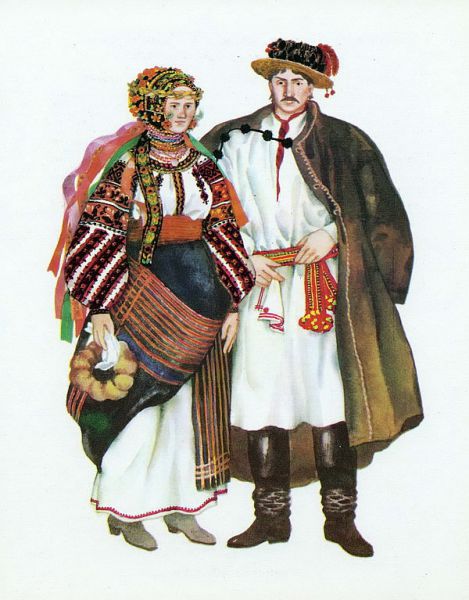
The origin of the name Podillia is easy to deduce from the words "on" and "Dol"(lower part; settlements located in the river valley). Here associations with Polesie arise, and it is no coincidence. Only if in the northern region people settled "through the forest", then in the case of Podillia - "On the dale", that is, in the valley between the rivers Southern Bug and Dniester.
Learn about the life of Podolyan in the following museums:
- (Dunaevtsy town, Khmelnytsky region).
- (Bush city, Vinnytsia region).
- (Mogilev-Podolsky, Vinnytsia region).
Middle Dnieper
This is Central Ukraine. The name Dnieper is less common, and this is understandable, because it does not fully correspond to the truth: many lands are located along the Dnieper, and not only Ukrainian, but also Russian and Belarusian. Therefore, the name "Middle Dnieper" in relation to the Ukrainian territory is the most accurate.
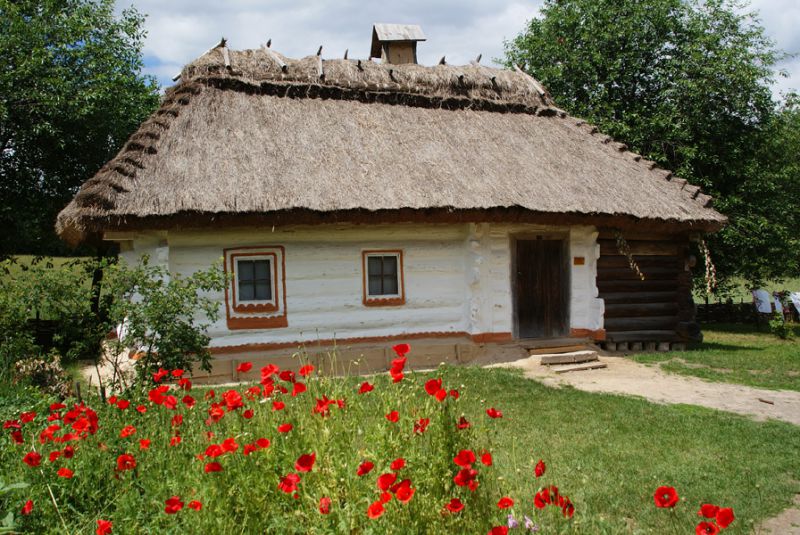 Photo source: etnoua.info.
Photo source: etnoua.info.
This region includes:
- Kiev region ( southern regions);
- Chernihiv region (southern regions);
- Poltava region (south-western regions);
- Kirovograd region (northern regions);
- Cherkasy region.

The following museums will tell about the life of the inhabitants of this region from ancient times to the present day:
- (Pirogov, Kiev).
- (the village of Petrikovka, Dnepropetrovsk region).
- (Legedzino village, Cherkasy region).
- (Pereyaslav-Khmelnitsky, Kiev region).
- (Pereyaslav-Khmelnitsky, Kiev region).
- (settlement Buda, Cherkasy region).
- (Kanev, Cherkasy region).
today, 15:28
At the moment, the civil society of Donbass is rethinking many facts of the past. The events of the Russian Spring, the opportunity to freely discuss the past of Donbass without ideological clichés imposed by Ukraine and nationally concerned circles of the Ukrainian intelligentsia, allow us to objectively assess the past of our region. The proposed article is an invitation to the discussion of specialists and all people who are not indifferent to the history of Donbass, the main points that relate to the study of the past of our region.
When it comes to history, traditionally it means that historians must tell and describe the past from the point of view of those facts that are already known to science or are being reintroduced into scientific circulation. It is rarely voiced and even understood that turning to History presupposes a systematic approach to working with facts and, which is very important, that the writing of historical works in one way or another takes place from a certain point of view of the author. Consistency presupposes not a set of some eclectic ideas about the past or colorful stories and tales, but a thoughtful selection and alignment of facts in a certain logical sequence and completeness. Consistency means a certain general design, on the basis of which the entire amount is built historical facts... This is how history, its individual periods, is described by the best representatives of historical science.
The consistency allows not only to logically present the events of the past, but also introduces a very important aspect after it. Consistency gives an understanding of the past, explains the main meaning ongoing historical processes. Depending on the chosen worldview position, the principles of cognition are determined, as well as the use of certain techniques and methods of studying historical material - a common place is the provision that differences in theory and methodology give rise to different understanding of the course of history, social development, interpretation of individual events and phenomena.
History has a pragmatic aspect that links it to modernity and current life. It is regarded as that area of human activity, which should provide an answer to the questions of our time and the needs of society. There is no doubt that this is ideological request time and society... The change in society, the transformation of the social structure of society leads to a modification of views on history and the past.
The influence of modern currents in the study of history, based on postmodern ideas and degrading liberalism right before our eyes, a decline in the general historical culture over the 23 years of being a part of Ukraine, the transition to the Bologna system specially designed for developing countries - all this led to the fact that for historians of Donbass the return to the basic principle of the study of history becomes relevant: historicism... The concept of historicism, unfortunately, is leaving the methodological cage of a certain part of scientists. Historicism assumes that each individual phenomenon of history, each of its facts becomes understandable only in the general context of his era... The modernization of concepts and the very essence of phenomena leads to a distortion of history, which is most clearly seen in the example of the ideology of “Ukrainians”, which has become part of the program of reformatting the past by the reactionary part of the Ukrainian intelligentsia. Understanding the causal relationships between historical phenomena, comprehension driving forces, behind which the motives of the masses and individual historical figures stand, are only capable of introducing historicism into the description of the past. Such an approach eliminates the operation of fictitious facts - artificial in nature, - neutralizes certain facts and facts thrown by ideologically concerned historians that lead to a distortion of the actual historical picture of the past, returns to scientific circulation the groups of sources removed from the scientific historical tradition, hushed up events.
Description of the history of Donbass
When presenting the history of Donbass, painstaking work with historical material should precede. Exceptional importance should be attached to the presentation of facts, the introduction of new sources into scientific circulation, and their study. For a long time, sources on the history of Donbass have been distorted for other reasons, they were hushed up or not studied at all. In this regard, the introduction of new sources into scientific circulation, the publication of collections of documents, factual materials, the same archaeological collections, should have priority. Without source base a full study of the history of our region is not possible.
Simultaneously with the exceptional significance of the sources, the task in writing the history of Donbass is not just the reproduction of facts, but also their explanation is subjective, the evaluative nature of historical research as such. The main thing is that when reading any historical work, the reader's ability to go along with the author, historian or archaeologist that path through the sum of the facts, which he went to his conclusions. This is the only way to immerse oneself in the past and achieve an understanding of the historian's intention, and after that, his assessment of the events of the past.
A clear classification of the periodization of the history of Donbass is required, since each period has its own peculiarity and uniqueness. The qualification of history by periods initially carries with it a conceptual charge.
Classification of historical periods
The history of Donbass is distinguished by the presence of two historical periods, each of which belongs to independent civilizations. Stands out two civilizational periods in the history of Donbass:
1) finding Donbass in the system of cultural and historical ties with the world of STEPPE and VOSTOK from ancient times to the late Middle Ages;
2) the entry of Donbass into Russia and the Slavic Orthodox expansion to the South, starting from the time of Ivan the Terrible, where in the 17th century an exceptional place belongs to the penetration and consolidation of Russians and Slavs in the territory of Donbass.
Each of the periods is independent to the extent of non-intersection of the historical destinies of the peoples living in different time in the territory of Donbass. Regarding Donbass, in many respects, the two identified periods coincide with the classical division of history into Antiquity, the Middle Ages, New and Modern history, where the 17th century. is the border between the Middle Ages and New history.
First period, covering the Antiquity and the Middle Ages, can be divided into several sub-periods:
The appearance of the first people in the Donbass (Paleolithic and Neolithic);
The first producing types of economy in Donbass, Donbass as part of the ecumene of the Proto-Indo-European people (Neolithic and Early Metal Age);
History of Indo-European peoples on the territory of Donbass (Bronze Age and Early Iron Age);
Penetration of the Turkic peoples (early Middle Ages);
The entry of the territory of Donbass into the steppe state formations of Khazaria, Bulgaria, the Golden Horde, the Crimean Khanate, the decline of the Steppe after the defeat of the Horde by Tamerlane;
Second period associated with the formation Russian Empire and its fixing in the steppe part of Eastern Europe, Slavicization of the region, sub-periods:
Penetration of Russians into the river basin. Seversky Donets in the 16th century, the first Russian settlements; Russian-Turkish wars of the 18th century and the conquest of the lands of the Azov and Black Sea regions from the Ottoman Empire, the first wave of immigrants from Russia, Crimea, the Balkans to the territory of Donbass;
XVIII century as the beginning of the formation of the multinational diversity of the region thanks to Russian military and popular colonization, the beginning of the continuity of generations in the Donbass;
Formation of regional integrity during the industrialization of Donbass in the 11th - early 20th centuries;

Donbass during the existence of the USSR, the end of the formation of the people of Donbass as a separate sub-ethnos of the Russian people;
Donbass as part of Ukraine (1991-2014);
The struggle of the people of Donbass for independence since 2014.
When identifying sub-periods, it is especially relevant and in demand, at the moment, is the study of the history of Donbass, starting from the 17th - 18th centuries. to date. This period is most distorted in the historical tradition of Ukrainian nationalist historians. It will take a dedicated effort to restore the true history of Donbass.
The content of historical processes in the territory of Donbass
One of the important moments in the history of Donbass is the understanding that since ancient times, the region has been in the mainstream of the historical processes that took place in the Old World. This is the appearance of the first people on the territory of Donbass, dating back to the Paleolithic period, and ancient history Indo-European peoples, and the location of the region in the zone of influence of the civilizations of the Eastern Mediterranean and the East. The key period for Donbass is starting from the 16th - 17th centuries. It was from this time that a civilizational breakdown in the history of Donbass took place, associated with the arrival of the Slavic Orthodox world in the Donetsk steppes under the auspices of the Russian statehood.
Statehood in the person of Russia is the basis of the New and Newest history Donbass. Without the appearance of Russia in the Donetsk steppes in its state incarnation, there would be no history of Donbass that we know.
Concept historical development Donbass, starting from the New Age, should be built on the basis of the civilizing mission of the statehood of Russia, and not on ethnographic excursions from the past. This is, in fact, a concept civilizing approach descriptions of the history of the region, completely painted with the colors of Russian civilization.
The apparent substitution of the idea of statehood by a certain nationality - "ethnographic material", that is, a society with a traditional appearance without the foundations of statehood - has been and continues to be part of the strategy of the ideology of "Ukrainians" in distorting the history of Donbass. It is obvious that without statehood (represented by Russia) there would be no Donbass in its present form. The emphasis in Ukrainian historiography on ethnographic subjects, and not on the history of industrial centers, is meaningful. With the urban population of Donbass, about 90% of the total population of the region, while Donbass - largest metropolitan area Europe, rural districts do not play a special role in shaping the image of the region. The face of modern Donbass is a country of cities with its own urbanized culture. In this case, a clear understanding of the given originality of our land is necessary to counterbalance the historical concept of "Ukrainian ethnography" in the study of the past of Donbass. Donbass is the place where many peoples have shaped and created a new world by their labor, Donbass has become the crucible in which a new community of peoples has been formed on the basis of the Russian language and Russian culture.
The recent history of Donbass is essentially the result of the interaction of two independent forces: socio-economic and political (represented by Russia). This special symbiosis gave rise to the uniqueness of the region. Industrialization implies that the standard of living in large industrialized cities is higher than in rural areas. The economic component attracted people to Donbass, as is the current economic attractiveness Western Europe and the USA is the beacon that attracts the Ukrainian population to the "West". Donbass as a region was not a product of statehood in its pure form as the realization of "empire", imperial cities in the form of Kiev, Odessa. He had a pronounced historical path, asked by the industrialization of the region, which laid the foundation for the uniqueness of Donbass. Since its inception, the civil society in Donbass has had a certain independence and self-sufficiency due to the separation and remoteness from the political force of the State (political state power); people, society itself was guided by the economy, the pragmatic aspect of life.
Civilization mission visible in one more aspect.
Donbass remained in the general trend of progressive trends in the development of the world in the nineteenth and twentieth centuries. Progress, in the form of the emergence of innovations in the field of technology and as the basis for building a modern society, is recognized as unconditional in the modern world historical tradition. The ideas of Enlightenment and Progress, which constituted the spirit of modernity, were embodied in Donbass and became the cornerstone of its history. Progress has become the locomotive of the history of Donbass, especially since the accelerated period of industrialization of the region, starting from the second half of the 19th century. Thus, Donbass found itself in the general mainstream of world trends that were in Europe and North America during that period. This idea should be appropriately shaped in the form of historical works.
The progressive development of Donbass was understood from the first steps of its industrialization. Donbass was named “ New Russia"," Heart of Russia ". In this, Donbass sharply contrasts with the agricultural region of Russia and Little Russia, their traditions. It is not surprising that the substitution of the civilizing mission of Donbass with rural ethnographic material from Little Russia and Galicia became a political order of Ukraine. Such a substitution completely distorts the historical perspective and the true place of our region in the history of both Ukraine itself and Russia.
As a subtotal. The determining factor for the historical processes taking place in the Donbass was the Russian statehood. Donbass is a product and continuation of Russian statehood; in a somewhat transformed form, this direction of development of the region continued during the existence of the USSR. The unnatural process of Donbas entering Ukraine after 1991, with its orientation towards the West, has led to the tragic events of the last two years. 2014 should be regarded as the year of returning to the bosom of Russia, Russian history.
The basics that make up the concept of the history of Donbass
History is never independent. On her, to a greater or lesser extent, they leave their imprint on the ideology of one time or another.
The ideological component of the Donbass History Concept should be based on a sober view in assessing the historical processes that took place. Moderate conservatism can become the official state doctrine of the Republic. Conservatism is based on traditional values, where "work", "family", "spirituality" belongs to the primary place. Based on this, when describing history, special attention should be paid to the disclosure of these conceptual topics in a historical perspective.
- "Labor" as the basis for the formation of Donbass, the basis of its originality in Eastern Europe.
Description of the history of Donbass occurs through the disclosure of the topic working people, who built the largest industrial center in Europe in the wild, arid steppe, creating the largest agglomeration in Europe. The names of the founders of the cities and the leading organizers of production and leaders of the region should become the core around which the history of Donbass will be described; important is the chronicle of the construction of the largest industrial facilities in Donbass, the emergence of cities, their growth and improvement. Labor is the basis of the family's well-being; it is in this vein that the young generation of Donbass is brought up.

- “The multinational character of the region”, in the formation of which each nation has contributed to the creation of modern Donbass.
Joint labor different nations- the basis for the peaceful coexistence of peoples. The formation of the special character of the people of Donbass on the basis of the labor of many peoples and nationalities: enterprise and independence, the ability to joint actions, labor, cooperation, internal freedom and independence of each with the ability to cooperate.
- "Spirituality".
From the point of view of the meaning of history, Donbass became the place where the human personality overcame its dependence on Nature and its primary needs. Donbass has become a place where the pristine world was transformed into the World of human culture. The industrial image of Donbass is an example of the power of the Human Spirit. it pathos of creation in the realm of the Spirit. In this sense, a person acts as a product of his own historical fate, and not an elemental force of nature, completely subject to blind fate and nature. Man is the creator of his own destiny. The liberation of a person, his transformation into a conscious and creative historical figure is the main final content of the historical process of the formation of the people of Donbass. 2014-2015 events became a visible reflection of the freedom of the people of Donbass, making their own history and deciding their own destiny on their own. This is the spirituality of Donbass. The relationship between the spiritual and the natural in the historical process is the main pivot modern history Donbass.
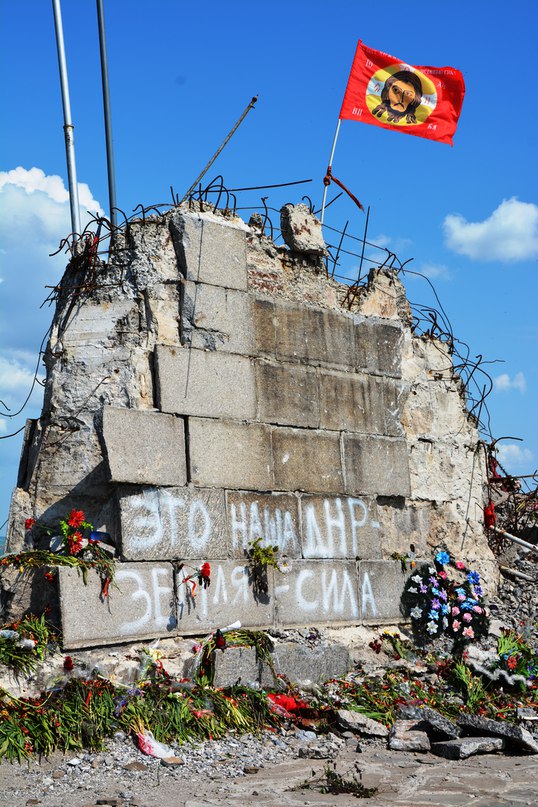
Practical tasks
The above outlines the directions in the study of the history of Donbass.
1) Creation of acceptable working conditions for the historians of Donbass. First of all, we are talking about the possibility for them to publish their scientific works within the DNR. The natural demand of civil society for historical scientific literature must be satisfied.
2) Historical works are the basis for the creation of textbooks for higher and secondary schools. In the present, a distorted situation arises when they first try to write textbooks that should meet modern needs, at a time when there are no fundamental historical works of an academic plan. The natural process has a different vector: academic science creates the necessary scientific basis on the basis of which textbooks are written, university science is formed. Hence the urgent need to build an academic system of historical science in the DPR.
3) One of the primary tasks is the formation of the academic historical environment in Donbass, which is currently absent. The creation of a full-fledged academic in nature Institute of History and Culture of Donbass should provide the foundations of academic science in Donetsk. An academic institution should determine the directions for studying the history of Donbass, develop a program of scientific topics, create scientific teams to write the history of Donbass, be a methodological center in the field of studying history, training highly qualified personnel for the scientific system and for all levels of government.
4) Expansion of scientific centers for the study of history should become a separate area. In this regard, the Donetsk Republican Museum of Local Lore is already an independent scientific center for the study of the history of Donbass. Regional museums of all levels require targeted support in preserving their scientific potential and further development.
5) On the basis of academic, university, and museum science, there should be formed its own historical tradition of studying Donbass outside the bounds of the imposed ideology of “Ukrainians”.
In the general vein of the tasks set, it becomes necessary to hold scientific historical conferences to reformat the directions of scientific study of the history of Donbass. In the same vein, it is necessary to hold conferences of local historians of Donbass, to form Local history as a separate area of study and popularization of the history of the region. Decades of the “History of Donbass” should be held in order to convey to the general public the true history of the region. The educational mission should be raised to a sufficient height, which is impossible without raising the prestige and role of educational institutions, first of all, existing museums, and providing them with appropriate assistance. Development of the primary plan for publishing activities on the history of Donbass, which includes both the publication of works of an academic format, university science, and popular science publications; it is necessary to allocate the necessary financial resources for this. It makes sense to revive the public organization "Society for the Protection of Historical Monuments", which has proven itself well in the Soviet period, there is a need to create an independent Committee for the Protection of Historical and Cultural Heritage under the Council of Ministers of the DPR with state functions of preserving the historical heritage of Donbass, the museum fund of the Republic, popularization of history the edges.
Such tasks are feasible only within the framework public policy development of science and with the direct support of the state and the general public. Such tasks are not solved on the basis of the enthusiasm and selflessness of individuals.
In the comments to the materials posted on our portal, it is prohibited to use obscene language that is offensive to the interlocutors and the authors of the materials of the vocabulary. For violation of this rule, comments will be deleted
This entry passed through the Full-Text RSS service - if this is your content and you’re reading it on someone else’s site, please read the FAQ at fivefilters.org/content-only/faq.php#publishers.
Donetsk People's Republic
MUNICIPAL EDUCATIONAL INSTITUTION
"SPECIALIZED SCHOOL WITH IN-DEPTH LEARNING OF FOREIGN LANGUAGES No. 115 OF THE CITY OF DONETSK"
Extracurricular activity
The festival
"Multinational Donbass 2017"
Prepared by:
library manager
Savina L. V.,
geography teacher
Koroleva N.N.
Donetsk, 2017
Theme:"Multinational Donbass 2017".
Target: 1. To form patriotic self-awareness, boundless love to the Motherland, to their people.
2. Expand and deepen knowledge about the history, cultural heritage of the Donetsk region.
3. To acquaint students with the culture, traditions of peoples, living in Donbass.
Equipment:Posters: “Multinational Donbass: we are united - and we live together!”, “We are different, we are together, the school is our common home”; multimedia equipment, presentations, videos.
Event progress
The music "Song of Donbass" by V. Makarov is played. (Slide 1)
Lead 1: (Slide 2) How to love the Motherland
I hardly need to say.
Everyone has one
And together with life it is given to us.
Lead 2:(Slide 3) Homeland, a big word. It begins for each person in the family and house where he was born. For you and me - at the mine, in the Donbass.
Lead 1:(Slides 4-6) The steppe here is endless, the sky is harsh. And there is no sunset more beautiful than the sunset over the headframe, and there is no smell dearer than the smell of coal and smoke.
Lead 2: I was born in Donbass,
In the land of coal and steel
Where it flickers at night
Star beam on copra. (Slide 7)
Where crimson shine
Pre-sunset distances,
Where is wheat like the sea
Pinkish at dawn. (Slide 8)
And how not to love our native land, the land of coal and metal, where every stone, every new house, factory chimney, sunrises and sunsets over the mine - everything sings the glory of the Man of Labor. (Slide 9)
Lead 1: So, so, so ... You were born in Donbass, and I was in Yamal (slide 10), this is the north of Russia, in the Arctic Circle (slide 11), but my family fell in love with the Donetsk region and live here.
Maxim enters from grade 8, singing: "I was born in Siberia ..." (slide 12)
Lead 2: And what does it mean?
Maxim, without answering the question, continues to sing: "A Kiev woman, a Kiev woman, a Kiev woman" (slide 13).
The presenters look at each other, shrug their shoulders, not understanding anything.
Maxim sings "My Belarus ..." (slide 14)
The presenters are trying to ask him a question, but Maxim is ahead of them, stops:
“Quiet, I reminded some of our dear teachers where their homeland is. People say: “where I was born, I came in handy there,” but our Siberian woman Nadezhda Nikolaevna, Kiev woman Victoria Vyacheslavovna and Belarusian Olga Anatolyevna came in handy, even very much, on the Donbass land, this is their second home, because
Donetsk land, dark complexion,
With gold in his eyes.
It's not easy to fall in love with him
You cannot stop loving him. (N. Rybalko) (Slide 15)
Lead 2: Donbass is an amazing land where wonderful people live. More than 100 nationalities live on the territory of the region. Probably, it is difficult to find a state in the world that is multinational in its structure. And this is not weakness, but strength. The Donetsk People's Republic, no matter how small it may seem to someone on the world map, is a multinational state. And proud of it! (Slide 16)
Russians, Ukrainians, Belarusians, Greeks, Tatars, and also Armenians, Jews, Azerbaijanis, Moldovans, Georgians, Bulgarians ... Someone once came to this land to conquer it, someone - to make it even more beautiful and richer. Yes, they stayed here. This land draws its wealth and strength from the multicolored peoples and their customs!
Lead 1: K of course, there are no bright colors here,
As in the Caucasus and Crimea,
And over the factories of Donbass
Sometimes the sky is full of smoke. (slide 17)
But there is a different kind of beauty ... (slide station 18)
Contemplate this beauty. (A. Kravchenko)
(Train slide 19) On the stage there are 2 carriages of the Druzhba train.
The sound of an approaching train is heard. Announcement is in progress. The sound of a train stopping.
... The Druzhba train arrived on the first track.
Participants of the festival in national costumes leave the train, holding the coat of arms, the flag of the people they represent.
Lead 2: Representatives of different nations have gathered at our festival. Let's welcome them.
A girl in the national costume of "Donbass" comes out with bread and salt, with the words: "Donetsk welcomes you as the most long-awaited friends."
Participants stand and everyone (who has attributes in their hands) says a greeting in their own language.
Girl in Donbass costume: Free land of the steppe, Cossack,
The temper of the people here is straightforward, but cool,
Having become a single, brotherly family,
Many nations live here.
1 guest: Like a bird in the blue sky, two wings wide open,
Donbass warmed half of the planet, one hundred peoples, one hundred tribes,
We are your own children, let the sky turn blue!
2nd guest: And dozens of different nations, villages and cities!
Our meeting is a common holiday
This land is our common home!
3rd guest: Our common home is called Donbass,
May everyone in him be comfortable
We will overcome any difficulties together,
Our unity is our strength! (Hold hands and talk together)
4th guest: Today we will introduce you to the culture, traditions and customs of the peoples whose representatives study at our school. The national cuisine is also an indicator of the culture of the people.
We send you a low bow to everyone (bow)
With a kind word and love,
Take salt, take bread
Live long and without troubles! (in chorus)
They put national dishes on the table. The rest go to their places in the hall.
Fanfare sounds.
Lead 1: Our festival "Multinational Donbass" is open.
Azerbaijan
Presentation "Azerbaijan".
(Slide 22) The Azerbaijani song "My Azerbaijan" is performed by Polad Bul-Bul oglu. Girls are dancing to the music.
Lead 1:(Slide 23) Azerbaijan is a country that sacredly observes its national traditions. Many traditions of Azerbaijan are embodied in the hospitality of this people, their culture, folk beliefs, national dress, folk customs.
Lead 2:(Slide 24) The hospitality of Azerbaijanis is widely known. A friendly welcome is given to everyone who crosses the threshold of the house with good intentions.
In Azerbaijan, they know how to receive a guest with a truly Caucasian hospitality and scope. In any home, the first thing a guest is offered is tea. It is always with tea that hospitality begins.
Lead 1:(Slide 25) The Republic of Azerbaijan, a state in the southeastern part of the Caucasus. Almost half of the country's territory is occupied by mountains.
Lead 2:(Slides 26, 27) The capital of Azerbaijan is Baku. This is one of the most beautiful cities world, located at the junction of Europe and Asia. The very name of the capital is interpreted as “blow of the wind”, “city of winds” or “hill”, “city on a hill”. Baku is the cultural, industrial and political capital of Azerbaijan.
Lead 1:(Slide 28) The most majestic and mysterious monument of Baku is the "Maiden's Tower". It has no analogues in the whole East and is a symbol of Baku.
The name "Maiden" means "unconquered", "unapproachable". The mystery of the tower has given rise to many legends associated with its name. A museum is located inside the tower today.
Lead 2:(Slide 29) Flame Towers is a symbol of a new and prosperous Azerbaijan. Glass skyscrapers in the form of tongues of flame directed towards the sky. Flame Towers are visible from anywhere in Baku.
Lead 1:(Slide 30) "Old town of Icheri Sheher". The most ancient residential area of Baku. In the middle of the stone streets of Icheri Sheher, time seems to have stopped its course - here you can fully feel the atmosphere and flavor of the country.
Lead 2:(Slide 31) "Bibi-Heybat Mosque". Monument of Islamic architecture of the 13th century.
Lead 1:(Slide 32) "Mukhtarov's Palace". Venetian style. The oil industrialist and millionaire at the beginning of the 20th century, Murtuza Mukhtarov, built a palace in the European style for his beloved wife.
Lead 2:(Slide 33) "Azerbaijan Carpet Museum". The museum's expositions are dedicated to the art of carpet weaving.
Lead 1:(Slide 34) Heydar Aliyev Center. A modern building that demonstrates the achievements of Azerbaijani culture. In 2014, this building received the World's Best Design Award.
Lead 2:(Slide 35) The population of Azerbaijan is about 10 million people. Azerbaijanis, Lezgins, Russians, Avars, Meskhita Turks, Talysh, Tatars, Georgians and representatives of other nationalities live in Azerbaijan.
Lead 1:(Slides 36-39) The Azerbaijani people, which is one of the most ancient peoples in the world, are rightfully proud of their historical monuments material culture, its rich literature, art, musical culture and famous people... (Video)
Lead 2:(Slide M. Magomayev 41) During this concert, before the performance, Magomayev was warned that the Minister of Culture would speak after him, but he was delayed and Magomayev was asked to play for time. After singing a song, he did not sing another, but turned to the audience: “I ask everyone present to repeat the movements after me.” I ask you to do it with me now:
Raise all your palms
And rub them a little,
Clap together five times
Keep rubbing!
My neighbor is so nice
I'll shake his hands
And another neighbor is good -
And I'll shake his hands.
It's time to raise your hands up
For our festival
Let's cry out amicable: Hurray!
Lead 1:(Slide 42) The national costumes of Azerbaijanis are very beautiful and distinctive. Women's dresses have a graceful silhouette and cut, emphasizing the flexible bodies of Azerbaijani beauties. They are decorated with intricate embroidery and trimmed with beautiful "gold" braid. Men's clothing is also distinctive. She emphasizes their masculinity, does not hinder their rapid movements.
A fiery dance with his swift movements is performed by a student of the 1st grade Aliskender Yagubov. (Slide 43) lezginka dance
Lead 2: (Slides 44, 45) Bright and original holidays in Azerbaijan. Novruz-Bayram is most widely celebrated on 21.03. on the day of the vernal equinox, but the festivities begin on 20.03. these days they bake sweets, treat friends, give gifts, ask each other for forgiveness.
(The boys go to the hall and treat guests to dried fruits, baklava)
Lead 2:(Slide 46) The richest rituals and ceremonies in Azerbaijan were and remain wedding ceremonies... At every wedding, the dance "Halai" is performed. Nobody remains indifferent to this dance.
(Boys are performing Halai)
Lead 1 and Lead 2(together):
(Slide 47) Come to us!
"You can get to Azerbaijan only once by accident, because every next time it will beckon you with its beauty, diversity and hospitality."
Israel
Presentation "Israel".
(Slide 48) Jewish folk music sounds quietly, presenters come out to it.
Lead 1: Israel is a small country in terms of territory, but large in content. After all, countries, like books, can be small in size, but so many great events happen in them, many great ideas and people are born.
Lead 2:(Slides 49-52) Born here: the sage Solomon and Jesus Christ, Moses led his people here, to whom God handed the Torah - the Great book, which says everything about our world. Therefore, Israel is sometimes called the Land of One Book. So, before you is a state in Southwest Asia.
Poem "Israel with Love" by Yakov Zalischak (accompanied by slide shows 53-58) (Appendix 1)
Lead 1:(Slide 59) Israel ranks 97th in the world in terms of population and 147th in terms of territory.
Lead 2:(Slides 60, 61) The Star of David is one of the symbols on the flag of the State of Israel. The Menorah is one of the symbols of Judaism on the coat of arms of the State of Israel.
The monetary unit is the new Israeli shekel.
Lead 1:(Slides 62-64) The people of Israel are diverse, differing both in religion and in belonging to national minorities. Mostly Jews and Muslims live in Israel. Israel is considered the cradle of three world religions: Judaism, Islam and Christianity.
Lead 2:(Slide 65) The education system consists of three stages, designed for 12 years of study. Students in an Israeli school study a lot of subjects on their own, one of the features of learning is that it is not necessary to learn the multiplication table.
Lead 1:(Slide 66) All Israeli citizens over 18 years old are required to do military service by conscription, for men it is 36 months, for women - 21 months.
Lead 2:(Slide 67) Israel is a country with unique traditions and customs, and therefore, everything that happens in it is also unique and inimitable. I must say that even the holidays in Israel are held in a peculiar way. Jewish holidays in this country are celebrated not according to the usual calendar, but according to the lunar calendar. And therefore the dates of these holidays are constantly changing and, from year to year, are not repeated.
Lead 1: On the first two days of the New Year - on the 1st and 2nd day - Jews remember how they lived last year, give gifts to relatives and friends, and gather around the festive table.
Lead 2:(Slide 68) The main New Year's treats are apples with honey, fish, round challah with raisins. And the traditional wish sounds like this: "Good and sweet New Year!" - "Shanatova at the metuk!"
(Children go to the hall, treat guests)
And, of course, it is not complete without songs and dances.
(The dance "Hava-nagila is performed)" (Slide 69)
Lead 1:(Slides 70-73) Israel is biblical "Promised Land". Here you can see a large number of interesting historical and religious monuments.
Jerusalem is one of the oldest cities the world. It is he who is considered " the capital of three religions ”. The city is surrounded by mountains. In ancient times, it was the capital of the state. On Mount of Olives there is an observation deck. From it you can admire the wonderful views of the city. The city has a large number of temples, mosques and churches. Jerusalem is home to one of the most famous shrines in the world - Church of the Holy Sepulcher. The greatest shrine of Judaism - Wall of Tears.
Lead 2:(Slide 74) Tel Aviv translates as "Hill of Spring". This city is considered the de facto capital of the state. The city is young, for this reason there are few historical sites.
Lead 1:(Slides 75, 76) Haifa is the third largest city in Israel. This is the largest sea port... The main attraction of Haifa is biblical Mount Carmel. According to legend, Elijah the prophet lived on this mountain.
Lead 2:(Slides 77, 78) Nazareth is the city where Jesus Christ spent his childhood. Franciscan Church of the Annunciation was built here in 1969. It is considered the largest cathedral in the Middle East.
Lead 1:(Slides 79, 80) Famous city Bethlehem (Beit Lehem) located south of Jerusalem. This city is considered place of birth of Jesus Christ. The main shrine of Bethlehem is Church of the Nativity, built in 326.
Lead 2:(Slides 81, 82) The Dead Sea is a unique natural monument. Its coast is considered the lowest land area on our planet.
The sea lies between Israel and Jordan. Tourists from all over the world come here for treatment and recreation.
Famous river Jordan flows into the Dead Sea. Israel's main river, the Jordan, is a holy place of pilgrimage.
Lead 1:(Slides 83, 84) Eilat is a resort city, one of the world's leading tourism centers. Located on the southern tip of Israel, every year it gathers tens of thousands of tourists on its beaches who want to plunge into the clear waters of the Red Sea, bask on the purest sand, stroll along the Embankment in the evening and listen to Jewish folk songs.
(Song "Tum balalaika, ...", performed by a boy and a girl)
Lead 2:(Slide 85) The journey to Israel has come to an end.
(Participants come out, speak together) But we do not say goodbye to Israel, but we say "Shalom!"("Hello!")
(Jewish music sounds)
Russia
(Slide) The music is playing softly
Lead 1: The physical map is laid out,
How many seductive names
Addis Ababa, Genoa, Jakarta,
Colombo, La Caruna, Lisbon.
They beckoned us exquisite gave:
Ottawa, San Antonio, Dalian ...
And next to us they lived and sounded
Moscow, Voronezh, Tula and Ryazan.
The song "Russia - Khokhloma, Volga reach" is being performed, accompanied by a slide show.
Presentation "Russia" (Slide "Map of Russia")
Lead 2:(Slides 1-3) If we look at Russia for a long, long, long time,
Then we will see both forests and cities,
Oceanic expanses, ribbons of rivers, lakes, mountains ...
We will see a distance without an edge, tundra, where spring rings,
And then we will understand how big our Motherland is,
An immense country.
From the South Seas
To the polar edge.
Lead 1:(Slides 4-5) Sochi is the most South part Russia.
The border of the Russian Federation with the countries of the Caucasus runs along the crests of the main Caucasian ridge.
Lead 2:(Slides 6-7) My Russia is huge: proud, multifaceted, unique. You will never cease to be amazed at the endless expanses, unique architectural monuments, generosity and spiritual wealth of the people. This is a country that carefully preserves traditions, wise traditions, songs, dances.
A dance is performed to the song "I look into the blue lakes ..." (video, slide 8)
Lead 1:(Slides 9-10) Russia is a bright country,
There are high mountains
And the great river
Where the water is clear
Like the sky is blue.
Lead 2: Volga - the daring of Russia and its beauty.
Volga is the glory of Russia.
Volga is a song of Russia.
(a fragment of the song "The River Flows ..." sounds)
Lead 1: Yes, indeed, where does the Volga end?
Lead 2: It is endless.
Lead 1:(Slide 11) Father - Ural! Here is a land, rare, almost unique in Russia in terms of the beauty of nature, its richness and diversity.
Lead 2:(Slide 12) It is difficult in the whole world to name another corner the globe, where more valuable gems would be concentrated.
Lead 1:(Slides 13-16) At the junction of Asia and Europe stands our beauties of the Urals,
Every stone is precious,
Every rock is ore, metal.
Lead 2:(Slides 17-19) And beyond the Urals
Trans-Urals,
And there is its own, different distance.
Lead 1: Unknown
Bear white Siberia,
Behind the stone, disappearing beyond the Urals,
She called, called into the silver expanse.
Lead 2:(Slides 20-21) - B - bi - ryak!
Listen to how it sounds!
Proudly! Rolling! Powerful!
Si - bi - ryak!
I would say more, Man
An immense soul!
I will answer ... look at the map -
Siberia takes more there
Than half the country ...
Lead 1:(Slides 22-24) Only a hero can walk Siberia.
Climb over the mountains, make your way through the dense forest,
Overcome the river flow and return home on time.
Lead 2:(Slides 25-27) I want to bow to you, Siberia.
Your forests and endless expanses.
Your fields, blue lakes
There is in our Siberian taiga
More than the sea is a miracle bowl,
This is Lake Baikal
Surrounded by wild rocks.
Lead 1:(Slides 28-29) And here are bitter frosts,
Blizzards, blizzards, mosquitoes in summer.
They do not languish here from the heat.
The bins are full of mushrooms and berries.
Spring and summer - twenty two weeks
And thirty - autumn, cold and winter.
Lead 2:(Slide 30) What's wider in this?
Where is the end of the expanse?
Or maybe there is no end to it?
But they reached out to her for a free share,
Desperate, Russian hearts.
Lead 1:(Slides 31-34) Look!
A volcano is smoking in the distance.
There is fog over the hills.
Here is the border of the Motherland.
And here is Great Russia
Before you ...
Great Ocean. (video, slide 35)
Lead 1:(Slides 36-43) Who was born in Russia, in love with Russia,
He gave her his heart and his soul.
Before her, majestic, I bow in obeisance,
About her, about Russia, I sing a song.
About white groves
And the downpours are slanting
About yellow cornfields
And the joy of spring.
Love Russia, love Russia!
And be faithful to Russia forever!
(the last words are spoken in chorus)
Lead 2:(Slide 44) A song is the soul of any nation, and dances are a part of the inheritance, before which no one can resist and will not look from the sidelines.
Dance "Quadrille"
Conclusion
Children come out one after another with the words:
Our differences (Jew)
We will admire. (Greek)
To give each other kindness,
And just smile. (Russian)
We are different? (Azerbaijani)
We are equal! (in chorus) everybody come out
And there are no barriers to friendship. (Belarusian)
We are all people, we are just people. (Georgian)
We don't need to quarrel! (in chorus) (slide 45)
Lead 2: It's good when they live peacefully, amicably. But it was not always so, 1941-1945. - The Great Patriotic War. The people of Donbass stood shoulder to shoulder and defeated fascism. And now, in our not easy time, peoples of different nationalities have united again to protect their native Donbass. (slide 46)
Lead 1:(Reads the poem "I Believe" by a pupil of the 97th school of Vlasova Yulia):
I believe: It will be - as before,
My Donetsk will live!
And they will dance again
Graduates circling.
Mothers will be in squares
Walk with the kids
And listen to the sounds of the wind
And the explosions - forget!
Problems and prospects for the development and placement of the population of Donbass.
Employment of the population and labor resources. Unemployment Problems and Ways to Solve Them
Living standards and education
Migration of the population of the region
Age and sex structure
Density and distribution of population
Numerical dynamics of the population and the demographic situation in the region
History of the settlement of the Donetsk region
The role and importance of the population of Donbass. Basic concepts.
POPULATION AND LABOR RESOURCES OF DONBASS.
Plan:
3. Characteristics of the population of Donbass:
Population- the main productive force of society, that is, it is the natural basis for the formation labor resources and acts as a consumer of material goods, and thereby determines the development of industries that are oriented towards the consumer in their placement.
From the size, dynamics and structure of the entire population, labor resources, the level of its general preparedness and special qualifications, professional and labor skills, to a certain extent, both the development of the economy and its location in different regions depend.
The population located on the territory of Donbass is not homogeneous in composition, it differs in the ratio of the number of men and women in general and in age groups, in terms of demographic composition. These differences are especially significant in urban and rural areas. The study of the demographic structure of the population makes it possible to establish the possible size for the future and determine its shifts. In recent years, the birth rate in the region has decreased, the mortality rate has increased, there is a migration outflow, which significantly affects the change in the number, quantitative and qualitative composition of the population.
Thus, a comprehensive study of the demographic foundations of the population in the regional aspect is the basis for the most correct solution to the problems of employment of the population and the quality of its life, since it involves an analysis of the composition of the population by sex, age, characteristics of population movement due to natural growth and migration.
It is well known that Donbass is one of the most late populated territories in Ukraine. Until the fifteenth century. there were no permanent settlements here. But already from the end of the 15th century, the Donetsk and later the Azov steppes began to be populated by the Don and Zaporozhye Cossacks, which led to the formation of the first permanent settlements. This process accelerated with the creation of the Belgorod notch line - a defensive line from the raid of the Volga and Crimean Tatars. Among such settlements is the Domakha (Kalmius) watch post, which arose in the 16th century on the territory of the present city of Mariupol. In the seventeenth century. Cossack settlements also appeared near the town of Yasinovataya, with. Iron, s. Slavyansk, with. Lozovaya, etc.
The settlement of the region accelerated after the reunification of Ukraine with Russia (1654). Before the reunification, the southern provinces of Russia included only the northern part of the modern Donetsk region, and the rest of its territory (up to the Kalmius river) was administratively subordinate to the Zaporizhzhya Sich. The mining of rock salt in the area of Slavyansk and Bakhmut (Artemovsk) was of particular importance for the development of the region in the pre-capitalist period.
After the abolition of the Zaporizhzhya Sich (1775), the tsarist government, interested in the development of its southern border outskirts, opened wide access to these rich, but still rarely inhabited lands to foreigners, mainly Slavic immigrants from Austria and Turkey - Serbs, Bulgarians, Croats, and also to Moldovans. Military settlements were created from the arrivals. Some villages founded by settlers from the Balkans at the end of the XVIII - early XIX centuries, have retained their names to the present day (Krinichnoye, Troitskoye, Luganskoye, etc.). In the river basin Bakhmutki Poles settled in the coastal part of the region after the annexation of the Crimea to Russia, the Greeks moved, who founded in 1789 on the territory of the former settlement of Domakha, the city of Mariupol. V different places Turks and Tatars as prisoners of war settled, as well as Armenians (usually in large settlements), gypsies, and Jews. This is how a multi-tribal population developed on the territory of the region, in which, however, Ukrainians predominated.
Colonization played an important role in the settlement of the Donetsk region. The government distributed huge tracts of undeveloped land to Russian officers who expressed a desire to engage in arable farming. During the period of serf colonization, the richest resources of the Donetsk region began to be exploited, but the pace of their development was very slow. Coal mining began in the 40s of the 18th century. The development of antimony - mercury (in Nikitovka) and copper (in the Artyomovsk region) ores, as well as gypsum and other natural building materials, also began in the pre-reform period. From the end of the 18th century. handicraft enterprises for the processing of agricultural raw materials began to appear. At the same time, in the pre-reform period, industry was just emerging. Low level of development productive forces found reflection in the structure of the population and its distribution. In 1859, there were 4 cities here: Mariupol (1789), Bakhmut (1783), Slayansk (1784), and Starobelsk (1753).
More intensive settlement and economic development of the territory of the Donetsk region is associated with the beginning of its industrial colonization. The development of capitalist industry has raised the demand for labor force, and here all the accelerating stream rushed "liberated" from the land of the peasants from other regions of Ukraine and Russia. By the end of the 19th century, the average annual population growth here exceeded the average Ukrainian indicator by about 5 times and amounted to 100 - 150 thousand people annually.
With the abolition of serfdom in Russia, the necessary conditions were created for the rapid growth of capitalist industry. Coal mining has been developing especially rapidly since that time, metallurgical, coke-chemical, later - machine-building, chemical and other industries appear. industrial production which, in turn, caused intensive transport construction.
Release industrial products in the Donetsk region for half a century (from 1861 to 1913) increased by more than 15 times. This process led to the beginning of the formation of the working class and the modern network of its settlements - mainly mining and factory settlements. Based on coal mining, metallurgical industry and the development of transport, the industrial settlements of Yuzovka, Chistyakova, Khartsyzk, Ilovaisk (60s), Debaltsevo, Konstantinovka, Krasnogorovka, Krasny Liman, Yasinovataya (70s), Yenakiyevo, Kremennaya (80s) Dmitrievka, Lozovaya and other.
Against the background of Ukraine, Donbass stood out for its low population density (32 people / km²), a low proportion of the urban population (7%) and an intensive process of urbanization of a wide network of small workers' settlements. The rural population lived in small rural settlements (for example, the average population of the Bakhmut district in late XIX century was 300 people)
The years preceding the First World War were periods of further growth of the region's industry and an increase in the number of urban settlements. On the territory of modern Donetsk on the eve of the world war, more than 70 thousand people lived, including 32 thousand in Yuzovka itself. During the years of the revolution and the civil war, the region's industry was almost completely disabled, which led to the “depopulation” of cities and towns.
During the period of socialist industrialization, the region became one of the most important industrial areas countries with an increasingly expanding economic structure. Stormy economic development Donbass in the years of the pre-war five-year plans contributed to the rapid growth of the population, especially urban, and a change in the general pattern of settlement. During this period, 18 settlements were organized into cities. Among them are such as Kramatorsk, Gorlovka, Konstantinovka, Krasnoarmeysk, etc.
The temporary German-fascist occupation brought ruin and resettlement of the indigenous population. Rural settlement has also undergone significant changes, both in the location of the network of settlements and in its territorial distribution. Intensive outflow of rural settlements for the period from 1939 to 1970 was observed both in the areas immediately adjacent to the mining strip and in agricultural areas (Starobelshchina).
An analysis of shifts in the geography of the rural population shows that, despite significant quantitative (an absolute decrease in the number of villages and the size of the rural population) and qualitative (consolidation of villages, the formation of a new, more rational settlement system, the creation of better conditions for economic and cultural life workers) change the network of rural settlements as more inert in comparison with the network of cities, it needs a radical reconstruction.

